#michael warder
Text
Former Unification Church Official, Michael Warder, Analyzes Moon’s Organization
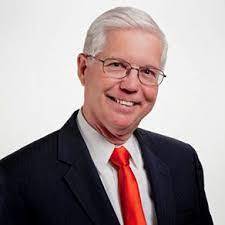
▲ Michael Warder
“The devil’s boots don’t creak.” – Scottish Proverb
Many who take money from him, attend his conferences, or publish their articles in his publications will point to his anti-Communism. Others support the civil liberties issues he seems to embody. Some reassure themselves by seeing the influential people with whom he travels. A few employ the rationale of the lesser evil; the powers that be are so malevolent that collaboration with him to obtain resources for a worthy project is justifiable. Still, the clergymen, scholars, policy analysts, journalists, and the host of others who have been taking large amounts of money from him might do well to consider Sun Myung Moon’s purpose, beliefs, and methods.
From the Divine Principle – Moon’s statement of theology that he and his followers regard as the Complete Testament (after the Old and New Testament) – we read that the ideal form of government is “theocratic socialism.” This is a rule of saints who will gather around the Second Coming of Christ to establish the Kingdom of God on earth. Christ, as the visible expression of God, will be analogous to the brain and the saints to the nerves in this ideal body politic.
The Messiah will, in accordance with God’s Providence of Restoration, have been born in the chosen nation of Korea between the years 1917 and 1930. Moon, of course, was born in Korea in 1920. In addition to these and many other hints in the Divine Principle, in his talks and by his actions in various church ceremonies and administration, Moon leaves absolutely no doubt about his Messianic claim, although making such a claim in public would be terribly bad form.
When will the Kingdom come? At one point Moon taught it would come in 1960; later it was pushed back to 1981 and then 1984. The Kingdom keeps being pushed back because the followers aren’t measuring up to the required standards of faith and deeds and the level of sacrifice needed for its establishment and success. Then there is the further problem of Christians and America not heeding the call. The diaspora and the Holocaust, according to Moon, stem from the refusal of the chosen nation of Israel to accept Jesus Christ. If America and Christians do not respond to Moon, they can look forward to a fate much worse than that of the Jews.
Few Americans, whether they are anti-communists or aging civil rights leaders – pay much attention to Moon’s theology. Some believe it is simply a sham to gain Moon wealth and power. Others find his ideas so unusual that they are dismissed out of hand as syncretistic and harmless heresy. Yet the movement devotes enormous resources to the spread of the ideology in lectures, books, videotapes, and audiotapes.
Members spend much time memorizing these ideas, lecturing on them, and finding corroborating evidence.
It would be a mistake to disregard Moon’s theology as unimportant, since it is a major component of the movement. As to wealth and power, Moon makes no apology for his effort to gather these. You need all the wealth and power in the world if you are lord of the universe and your mission is to establish the Kingdom of God on earth.
People who come into contact with the Moon movement often sense there is a hidden agenda behind the immediate cause for relating to a member of the movement, but they can’t quite put their finger on it. Outsiders are treated like honored guests in the hope that they will convert and bring their friends along. If famous professor Y participates in a publication or conference but shows little interest in joining the inner core, perhaps he will lead to professor X, who will. Outsiders who participate in Moon front groups perform a number of functions: they prevent the inner core from being isolated from the greater society; they provide legitimacy for Moon and his movement to other outsiders; they reinforce the members’ and potential members’ faith in Moon; and they provide a continual supply of potential inner members. The outsiders also contribute their specific expertise to Moon organizations which shadow all the organizations of normal society in such diverse areas as: religion, education, business, media, politics, and the performing arts. The front groups serve as training grounds and perhaps the actual institutions which one day will replace their extant Satanic counterparts on the road to the Kingdom.
There are literally hundreds of these organizations, which all reinforce one another, with key Moon operatives sitting on their boards. For example, the Washington Times, the New York City Tribune, and the magazine Insight, are owned by News World Communications which, in turn, is owned by One-Up Enterprises, which is owned by the ultimate holding corporation, Unification Church International. When leaders of the Washington Times say the newspaper is separate from the “church” and is funded by businesses of church members, there is a grain of truth to it because the paper is a business, as are News World Communications and One-Up Enterprises. For its part, Unification Church International has only Koreans on its board, with Mrs. Moon as its nominal chairman. Despite its name, UCI does not function as a church. It is more of an international clearinghouse for many of the movement’s activities, including the businesses. Although Moon’s name might not appear on the flow charts of this organizational scheme to protect him, he is the acknowledged founder of some of these organizations. In an operative sense, Moon owns all of these enterprises because of [no] major decisions about personnel or money are made without his personal approval.
This brief outline in no way does justice to the countless organizations Moon has begun. Still, some of the businesses aren’t in this structure, nor are the businesses based in Korea, Japan, Europe, and countries all over the world. There are also organizations that do not relate to business, such as the International Cultural Foundation. The ICF is an American-based tax-exempt educational and charitable organization whose board members are church leaders from around the world, with Moon as chairman. Each year ICF sponsors the International Conference on the Unity of the Sciences, a multidisciplinary gathering which discusses science and values. The ICF receives its money from the Unification Church of America. The Professors World Peace Academy is a program of ICF, but organizations of the PPWA preexisted the ICF in both Korea and Japan.
While a thorough knowledge of the corporate structures and accounting may be necessary, it is not sufficient to understand how the Moon movement functions. The real lines of authority and accountability begin with Moon and extend outward with trusted Korean, Japanese, and national leaders from the various countries. The organizations are simply convenient fronts to relate to the broader society. Expertise within the movement and outsiders is used and may carry some weight, but in Moon’s kingdom spiritual authority derives from loyalty, length of service, and level of sacrifice. Moon extends his authority through the faithful, and his favor may blow hot or cold depending on the circumstances. Organizational charts are secondary.
The international dynamic of the front groups is rarely perceived. If the Washington Times is influential in Washington, it’s difficult to imagine its impact in Seoul, where national security and connections in America’s capitol are the beginning and end of power. Hundreds of copies of the Washington Times are flown regularly to Korea for distribution throughout the government leadership there.
It would be difficult to shut Moon down in Korea considering his bases and contacts in Japan, America, Europe, and the rest of the world. Nonetheless, from time to time the Korean government has jailed members of the movement and made the export of ginseng tea and other products Moon deals in difficult. To counteract such pressures, Moon has attempted in every way to make his movement indispensable. His machine tool business, Tong Il Enterprises, fulfills major government contracts for the production of weapons and parts that include rifles as well as more sophisticated weapons systems. While Koreans are impressed by Moon’s contacts in Washington, visitors to Korea may be similarly impressed with Moon’s operations. Beneath the surface, the realities, of course, are very different. The big names around Moon’s front groups in America and Korea care little for Moon’s ultimate claims. In fact, Koreans treat Moon about the same as Americans: most think he is a dangerous charlatan even as they take what benefits he has to offer them.
Peeling back the many layers of the Moon movement, one encounters the core members, whose daily life is an experience most Americans would not be able to imagine or believe possible. Among others, Eileen Barker, Frederick Sontag, John Lofland, and Marc Galanter have studied the lives of members of the Unification Church with some care and from differing perspectives. According to their findings (and my own personal experience), members are generally better educated than the average person, but they are alienated and dissatisfied with their lives. They have rejected the more typical paths of education, career, or religion. They are searchers looking for the basic answers to the basic questions of life: Who am I? Where did I come from? Where am I going? The number of neurotics who join might be slightly above the average, but not much. Psychotics who walk into lectures or workshops are weeded out in the recruitment and early indoctrination process. Moon’s ideas and projects provide a total answer and a plan of action for the spiritual quest and the acolytes’ desire to create a utopia. For yet others the initial personal appeal to join is an important factor.
For these members, obedience is the highest virtue, a means for the purification of one’s soul. Members believe their spiritual leader is the incarnation of God who has revealed the highest level of spiritual truth. Who can question his orders? The workdays go 18 to 20 hours seven days a week. After an early morning (as early as 4:30 am. but no later than 6:00 a.m.) worship service, members go off on an often bewildering array of duties which includes selling products, recruiting people for lectures and weekend retreats (“witnessing”), or working for the numerous organizations mentioned above. Evenings are a time for door-to-door witnessing, lecturing, or fundraising. Late night prayer services are held, and then it’s off to rest. But there is always some special prayer condition or a fast to ensure that people are always making an extra special effort.
Life is simple for the full-time fundraisers (about 25 percent of the movement). After the worship service and organizational meeting, they go all day asking money in exchange for flowers, candy, or some other cheap disposable item. A major hazard on the MFTs (Mobile Fundraising Teams), given the long days, is the possibility that the van driver will fall asleep at the wheel late at night while driving back to wherever it is that the team is sleeping. The number of death, injuries, and near misses is not known, but for those on the MFT it is a nightly reason for prayerful concern, since they do occur with disturbing frequency. In the 1970s, auto insurance coverage was terminated based on accident experience.
There is no paycheck for full-time members. Nor is there medical, hospital, or life insurance, or a pension plan. For those who are paid for working with outsiders in businesses which must conform with the minimum wage and other laws, there are set procedures for the money to be turned over to the church. Nonetheless, there are discrepancies between members who work in businesses employing outsiders and those who work internally, and these are a source of continual tension.
In church centers the food is cheap, with low amounts of protein. Rice, tasteless soups, and all manner of goulashes are a regular feature. For those who can’t take another night of ersatz dinner, there is always peanut butter and jelly. For a change of pace, a member may splurge on a Big Mac, and those on the MFTs will often sustain themselves on fast food. Of course, for recruitment activities involving outsiders, the food is good and can even be lavish for VIPs.
Marriages are arranged by Moon, often between persons who have never seen each other and whom Moon sees for the first time in a large roomful of men and women on either side. International and interracial marriages are encouraged and involve thousands of persons. There is a strict requirement of celibacy before marriage. In 1970 Moon married 791 couples; it 1975 it was 1,800 couples; in 1982 there were 2,075 couples in Madison Square Garden and 5,800 couples later that year in Korea. While the wait for marriage can be many years, couples are not allowed to consummate it for periods ranging from two years to sometimes as long as seven years. Moon makes that most intimate of decisions for others, since fallen people lack the spiritual authority to marry in the first place.
The marriage ceremony is a kind of combination of the sacraments of baptism, communion, and holy orders. It is only possible because Moon and his wife have arrived on earth as the new Adam and Eve who, by their spiritual authority, may extend the dominion of God through the marriages. When the time to bear children arrives, church women are often older and not in good physical condition. (Abortion does not have the stigma in Moon’s church that it does in the more orthodox Christian tradition. It is believed that the spirit enters the child when he breathes in his first breath of life.) Since child-rearing is a distraction from those long days of devoted service to build the Kingdom, the church has established nurseries in which the children are placed after three months. Staff at the nurseries are assigned to as many as five infants who are raised listening to Korean language tapes. After three children, the wives may leave their church mission and rejoin their husbands, with scarcely any emotional or financial foundations for building a family.
The psychological scars on the children and family life itself are perhaps some of the most serious consequences of the movement. The parents are expected to be responsible for their families while remaining devoted to the cause. There are, of course, exceptions. Like totalitarian movements anywhere, the leadership is subsidized by the cadre and may get by without supporting their own families.
While some church leaders have impressive clothes and cars, they may have little else. If they are in the upper echelons, have put in many years of loyal service, and have Moon’s favor, he will make sure they are taken care of, but they have no money of their own. Indeed, there is the bizarre spectacle of the children of Korean members going to Ivy League universities while other church members just starting out family life have to make do with inadequate diet and poor clothing. When the babies come, these couples face hospital and medical debt from lack of insurance, savings, and regular income. The assumption behind this approach is that Moon is the brain, the leadership, the nerves, while the members are only the responsive body. The members’ duty is not to question but to give wholeheartedly in the belief that God will provide for their future.
Of course members cannot help but raise questions about this Unification way toward the Kingdom which seems to leave them so powerless. In ways strangely similar to racist American whites who believe in the inferiority of blacks, Orientals in the movement teach Western members that their Oriental culture is superior to the materialistic culture of the West, weakened by drugs, pornography, and moral decay. This condition of weakness and inferiority is explained by Moon’s view of history which teaches that while Christian Europe was in the center of God’s providence, the Orient is the land of the new Christ and the new dispensation. Korea is a chosen nation, and Moon teaches that the Korean race is connected biologically to the lost Hebrew tribe of Dan. Moon is believed to be descended from the lineage of Abraham as well as Confucius. According to Moon, Koreans are culturally and racially superior to Caucasians, who in turn are superior to blacks. Each race has a uniqueness in God’s plan, but there is a hierarchy. The Orientals are spiritual and wise, while Westerners are rational and scientific. Blacks, according to Moon, have rhythm, physical ability, and emotionality.
Since whites are too white and blacks are too black, interracial marriages are seen as an especially good way to break down racial extremes. But prototypical couples of the same nationality or race can serve Moon’s purpose, too, as models for the rest of a given nation or race to follow. The Korean racial group is just right, and if the rest of the world were homogenized, the human race would, one is led to believe, resemble the Koreans.
The consequences of these stereotypes are reflected in the hierarchy and administration of the movement. Koreans are topmost, Japanese second, American third, and Europeans fourth in rank, with Germans leading the continent. In planning activities and making personnel changes, these rankings are taken into consideration. Moon has targeted America for his activities because he believes it the most powerful country in the world, that can also serve as a bridge between the Orient and Europe. In assigning missionaries, Europeans are responsible for Africa; North Americans for South America; while Japanese are responsible for Asia. Locals have some leadership responsibilities within the proscribed limits but serve mostly for image purposes. Ultimate control resides with Moon and the Korean elders.
Needless to say, Moon’s concepts of race are deeply buried. But the problems of the West, especially sexual morality, materialism, and individualism, are continuously contrasted with the virtue of the Oriental way – the closest to the way of heaven. Not much is said of the social problems of Korea or the weaknesses of Oriental culture. The social acceptability of kiseang girls along with the inflexibility and provinciality of Korean society is never discussed. Of course the desires for wealth, status, and sexual satisfaction exist in Korea as well but are pursued according to slightly different rules. In addition, there is a repression of individual creativity there greater than any we might experience in the West. The “Hermit Kingdom” of Korea is facing the problems of modernity like all Third World countries and has no special claim on virtue.
Within the movement there is no foundation for the ideas of freedom, the rule of law, and the dignity of the individual as they are understood in the West. While Moon’s theology borrows from Christianity, in an admittedly unusual manner, Moon’s concepts of leadership and society are Confucian with a strong emphasis on social conformity and loyalty. Rational criticism or internal disagreement on methods causes the Korean leadership to lose face and is tantamount to sedition or revolution. As is true for much of the Orient, new ideas or criticism are better offered through back-door channels at a propitious moment. Nonetheless, Moon utilizes the advantages afforded by the First Amendment and the Western legal tradition when they protect his freedom to operate in America. Within the leadership of the movement these fundamental Western civic norms are seen as mere expedients to build a totally new culture and political system.
Conservatives and liberals who collaborate with Moon might do well to look more deeply at what he believes and the actual practices of his movement. Ronald Reagan and Walter Mondale have more in common with each other than with Moon. Anti-Communists should be repulsed by Moon’s overt “theocratic socialism” with its model of the total state. Free enterprisers might consider Moon’s position on the state, individual choice, private property, and legality. Traditional conservatives might well look into the messianic claim, the assertion of Korean cultural and racial superiority, as well as the movement’s family practice. Moon’s political and religious views are repugnant to conservatism, even if his totalist claim is anti-Communist.
Some say it is unfair to label Moon a totalitarian. After all, he does not torture or execute people. The members are not locked in Church jails. True enough. Nonetheless, Marx never jailed or executed anyone, and even Lenin and the Ayatollah began with ideas and organization. The question to be asked is, where are the ideas headed and what is their goal? There is little question that Moon would have no ethical conflict with running a regime as absolutist as the Ayatollah Khomeini’s. Moon believes, as do his followers, that his authority, purpose, and decisions are the will of God. Those of a different persuasion are of the devil. Moon’s claims to authority make papal infallibility seem weak by comparison.
Liberals who identify with Moon’s movement as a religious or racial minority might do well to probe the unpublicized assertion of racial superiority and the total failure of the movement to understand the dignity of the person, the due process of law, and the freedom of expression in other than a cosmetic, public relations sense. Sacrificing human life for the will of God is ingrained in members from the first lectures, and Western ethical or legal angst is derided as symptomatic of a lack of clearly defined social purpose and definition.
Most people concerned with ideas like the financial support and publicity that traveling with Moon makes possible. The problem is that association with Moon legitimizes his theology and his messianic claim, both of which are odious to virtually all serious thinkers, not to mention the average citizen. If Americans who would be opinion leaders take Moon’s money or the publicity for appearing in his publications, they undermine the ideas they purport to believe in. They, then, are the ones whose ideas are a sham.
Michael Warder is executive vice president of The Rockford Institute and was formerly an official in the Moon movement.
Cult Observer, Vol. 5, No. 5, 1988, p. 10-13
_________________________________
Michael Warder explains Moon’s News World media strategy
Michael Warder’s reasons for leaving. As a top UC leader in the US in the 1970s he reported directly to Moon.
Moon’s 1982 Tax Case
Guilty Father – Monday, May 31, 1982 – TIME
Throughout the trial, which lasted more than six weeks, the evangelist’s attorney, Charles Stillman, insisted that the cash and stocks, although held by Moon, actually belonged to his Unification Church and were therefore not subject to taxation. One key witness for the prosecution was Michael Warder, 35, a former church executive who now works for the conservative Heritage Foundation in Washington, D.C. He testified that on several occasions Kamiyama had turned down his requests to use funds from the Chase accounts for church purposes with the explanation that the bank deposits were “Father’s money … not accessible.” LINK
_________________________________
Sun Myung Moon: The Emperor of the Universe, transcript and links
The Resurrection of Reverend Sun Myung Moon
Sun Myung Moon – Emperor, and God
2 notes
·
View notes
Text
Prosecution Rests in Tax-Fraud Trial of Rev. Moon (1982)

New York Times - Arnold H. Lubasch - May 2, 1982
The prosecution has rested its case in the tax-fraud trial of the Rev. Sun Myung Moon after presenting 30 witnesses and approximately 1,000 documents.
In four weeks of presenting the evidence in Federal District Court in Manhattan, the prosecutors sought to show that Mr. Moon had deliberately failed to report more than $150,000 of personal income on his tax returns from 1973 through 1975.
Mr. Moon, the 62-year-old Korean evangelist who heads the Unification Church, contends that he had merely been holding church funds that were not subject to income taxes. Judge Reserves Decision
On Friday, after hearing arguments by both sides, Judge Gerard L. Goettel reserved his decision on a defense motion to dismiss the charges on the ground that the prosecution had failed to prove its case.
The prosecution's last witness was Dr. Herbert Rowe, a former manager of a paper-manufacturing company. Dr. Rowe said that some key church documents that were supposedly signed in 1973 were written on paper that was not manufactured until 1974.
When asked if the manufacturing date was proved by a watermark on the paper, he replied, ''That is correct.'' The disputed documents were supposed to show that foreign church funds had been deposited in Mr. Moon's bank accounts, supporting the defense view that the accounts held church funds. But the prosecution contended that the documents had been created and backdated to obstruct the tax investigation.
When the testimony ended on Thursday, Martin Flumenbaum, a prosecutor, told the judge that ''the Government rests in its direct case.'' The prosecution team of Mr. Flumenbaum, Jo Ann Harris, James R. DeVita and Joan S. Alexander could present rebuttal evidence later.
Defense to Begin Tomorrow
The defense case is scheduled to begin tomorrow. The defense lawyers are Charles A. Stillman, Andrew M. Lawler and Bernard S. Bailor, who declined to say whether they would present any witnesses.
Mr. Moon is on trial with a co-defendant, Takeru Kamiyama, a top aide charged with helping file false tax returns and obstructing the investigation.
Prosecution witnesses included Chase Manhattan Bank officials who said that Mr. Moon had deposited $1.6 million in bank accounts, mostly in cash, and a Unification Church official who acknowledged that Mr. Moon had been given $50,000 of stock in a tea-importing company formed by the church.
Former Unification Church officials, testifying reluctantly under subpoenas, identified documents concerning a Westchester County estate where Mr. Moon and his family live.
The documents showed that the church had bought the estate in 1973 for $625,000, including $361,000 from Mr. Moon's accounts at Chase Manhattan. They described the $361,000 as Mr. Moon's ''personal money'' and said he had given it to the church as a ''loan.'' 'Not Accessible' to the Church
Michael Y. Warder, another former official of the church, testified under immunity from prosecution that Mr. Kamiyama had told him that the Chase Manhattan accounts contained Mr. Moon's money and were ''not accessible'' to the church.
Mr. Warder said he had been publisher of the church newspaper, The News World, and had held many budget discussions with Mr. Kamiyama. He added that he had lied to investigators about church operations to help Mr. Moon, but that the church leader had not told him to lie.
The charges against Mr. Moon accuse him of failure to report more than $100,000 of interest from the Chase Manhattan accounts, which were in his name, and $50,000 of stock issued to him by the teaimporting company, called Tong Il Enterprises.
If convicted, he could face a prison sentence of up to five years for conspiracy and three years on each of three counts of filing false tax returns.
A jury of two men and 10 women is hearing the case.
Source: NY Times
Related links and notes below
Ronald Reagan’s Diary Entry on Moon
Monday December 24, 1984
“Senator Orrin Hatch is after me to grant clemency to the Rev. Moon. I’ve explored this & find I just can’t. I have, however, taken action to see if I can grant him a furlough over New Years. It seems that day is the holiest in that religion.”
Washington Post: Moon’s Japanese Profits Bolster Efforts in U.S. (1984)
Information on COINTELPRO
Nobusuke Kishi wrote a letter to President Reagan to get Moon released from jail; he was in for perjury, document forgery and tax evasion in 1984.
That time Bo Hi Pak got scammed
Archive of Robert Parry’s Dark Side of Rev. Moon Series
#danbury#sun myung moon#moonies#unification church#takeru kamiyama#fraud#tax fraud#legal#law#investigation#1973#1974#tong il enterprises#uc assets#michael warder#michael y. warder#kamiyama#unification church in the united states of america#unification church in japan#unification church in the united states#american church
0 notes
Text

18+ indie kink heavy multi muse blog ft muses from supernatural , resident evil , witcher , marvel , dc & some original muses. more muses to be added when I feel like it.
not about policing content — content does not reflect the writer's views. very kink and smut friendly blog. expect mature even taboo content , ie violence , gore , n.sfw , torture , drug abuse.
mutuals only. be chill. read da caard.
CAARD. MEME TAG.

resident evil ; piers nivans ( b. 1987 . soldier )
left 4 dead ; ellis ( b. 1999 . mechanic , survivor )
cowboy bebop ; spike spiegel ( b. 2044 . bounty hunter )
sons of anarchy ; juice ortiz ( b. 1990 . mechanic, gang member )
marvel ; steve rogers ( b. 1922 . hero )
marvel ; michael morbius ( b. 1975 . vigilante )
marvel ; theodore altman ( b. 2000 . hero )
dc ; roy harper ( b. 1997 . hero; vigilante )
witcher cd projekt red ; lambert ( b. 1144 . witcher )
the wheel of time; lan mandragoran ( b. 953 . warder )
supernatural tv ; dean winchester ( b. 1979 . hunter )
interview with the vampire tv; lestat de lioncourt ( b. 1781 . vampire )
supernatural oc; james dietrich ( b. 1974 . werewolf )


2 notes
·
View notes
Text
By Alex Vadukul
As the tang of Canadian wildfire smoke wafted through Midtown Manhattan on Wednesday evening, hundreds of writers, editors and book industry veterans crowded into Cipriani’s cavernous ballroom on East 42nd Street to attend the centenary celebration of W.W. Norton & Company, the oldest and largest independently owned publishing house in the country.
Authors hung out by the bar sipping the evening’s signature cocktail, the Norton Cranthology, a mojito named after “The Norton Anthology of English Literature,” the doorstop compendium that has been a part of college curriculums since the 1960s.
The company’s sea gull colophon was projected onto walls. Tables were decorated with piles of classic Norton titles like “The Feminine Mystique” by Betty Friedan and “The Perfect Storm” by Sebastian Junger. Tote bags handed out to attendees came with a plushie of a baby gull named Norty.
To those in attendance, 100 years of Norton meant something, because there’s no other publishing house quite like it.
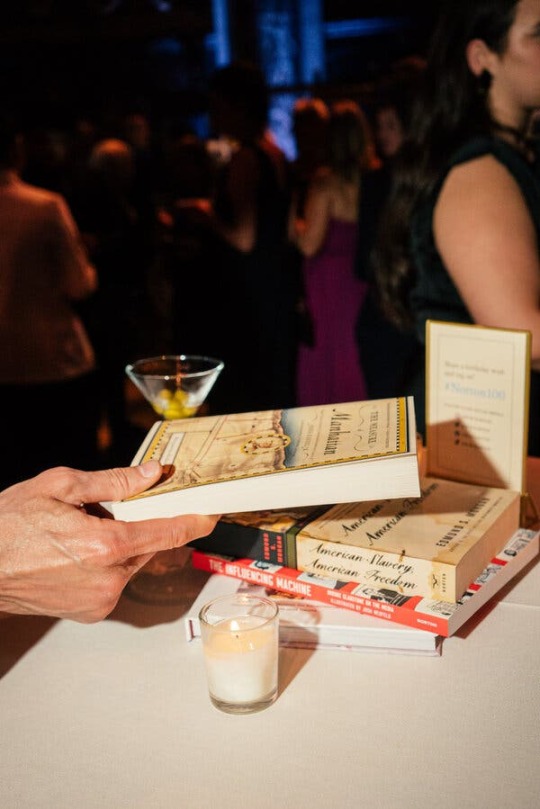
The memoirist Saïd Sayrafiezadeh with a copy of “The Measure of Manhattan,” a biography of the surveyor John Randel Jr. published by Norton. Credit...Jutharat Pinyodoonyachet for The New York Times

Norton’s sea gull logo. Credit...Jutharat Pinyodoonyachet for The New York Times
Co-founded in 1923 by William Warder Norton, the company began as a press for science and philosophy books. As it grew, it established itself with its canon-making anthologies, the novel “A Clockwork Orange” by Anthony Burgess and “Thirteen Days: A Memoir of the Cuban Missile Crisis” by Robert F. Kennedy.
Shortly after Mr. Norton’s death in 1945, his wife, Mary Dows Herter Norton, who was known as Polly and ran the company with him, entrusted it to its employees, creating the ethos of independence that defines Norton to this day.
While other legacy American houses have been swallowed up by European companies and corporate consolidation, Norton has occupied an increasingly defiant space in the industry as the only major publisher owned by its employees. The centenary bash at Cipriani was a celebration of the company’s refusal to capitulate.
To drive the message home, Norton asked five of its star authors to give speeches, and each was introduced onto the stage by the firm’s president, Julia Reidhead. First up was Michael Lewis, who has been a Norton author since the publication of his first book, “Liar’s Poker,” in 1989.
“Thirty-five years ago, I had the preposterous idea to write a book,” Mr. Lewis told the crowd. “I’d never set foot in a publishing house. I visited seven, eight, nine of these places. One of them was very much not like the others.”
The Norton offices, he added, resembled “your grandmother’s attic — after she died.”
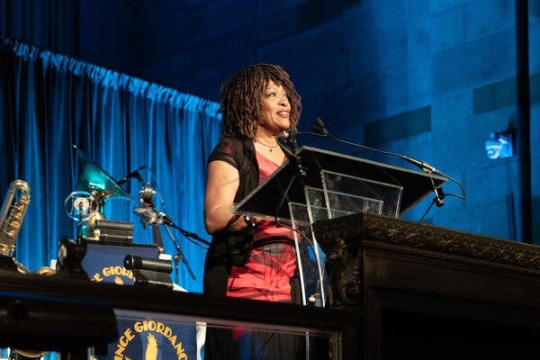
The poet, essayist and fiction writer Rita Dove. Credit...Jutharat Pinyodoonyachet for The New York Times
He ended by praising the company for deciding not to go along with industry trends, saying: “I’m grateful for your ability to resist temptation. Everybody else has been led down various paths and you have not.”
In her speech, Joy Harjo, the United States poet laureate from 2019 to 2022, recalled receiving a rejection letter from Norton in the 1980s, before eventually forming a partnership with the company that has lasted 30 years.
Neil Gaiman commended Norton as a stable haven for its authors, before describing the overall publishing industry as a once “healthy ecosystem” that had been consumed by “vast crepuscular creatures, somewhere between jellyfish and giant squid.” Rita Dove read a poem from her 1999 collection, “On the Bus With Rosa Parks.” And Richard Powers described his arrival to Norton as a third marriage that finally worked out.
Mr. Powers, who lives in the Great Smoky Mountains region of Tennessee, had flown to New York for the party. “They’re able to engage with books without looking over their shoulder and thinking, What’s corporate going to think?” he said in an offstage interview as guests nearby feasted on lobster salad and fusilli served with eggplant and mozzarella. “As a self-owned entity, Norton is essentially good old-fashioned 19th-century socialism.”
“When I told my editor I had a 560-page novel about trees, he didn’t bat an eye,” he added, referring to his Pulitzer Prize-winning work, “The Overstory.”

Norton’s offerings include books by Richard Powers, Neil Gaiman, Joy Harjo and Michael Lewis. Credit...Jutharat Pinyodoonyachet for The New York Times
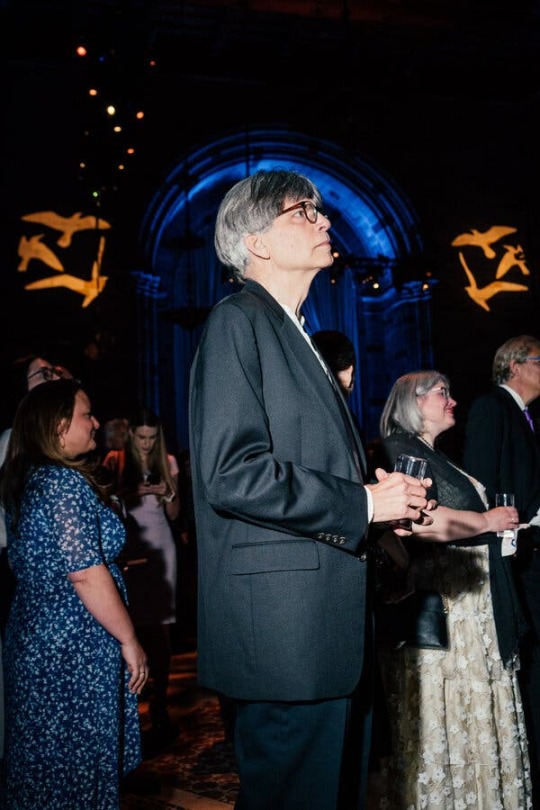
Richard Powers said that Norton is different from other publishers. “They’re able to engage with books without looking over their shoulder and thinking, What’s corporate going to think?” he said. Credit...Jutharat Pinyodoonyachet for The New York Times

Tote bags handed out to attendees came with a plush baby sea gull named Norty. Credit...Jutharat Pinyodoonyachet for The New York Times
Amid the swinging jazz sounds of Vince Giordano and the Nighthawks, Lake Micah, an editor who works for Harper’s Magazine and The Drift, nursed a whiskey sour.
“Now everyone’s about the bottom line, but Norton has persisted in spite of that,” he said. “And that’s because of the great faculty of worker-owned labor power, which is something that emanates from the left.”
He expressed some skepticism about the big bash.
“I mean, we’re here at Cipriani, so you can only imagine how much this all cost,” Mr. Micah said. “They’re still a business. They’re arguably doing the bare minimum in terms of what’s right, because all workers should deserve what’s fair.”
As the night drew to a close and publishing people mobbed the open bar for one last round, Alexia Norton Jones sat on a couch taking in the scene. Her presence represented a living link to the company’s heritage: She is a granddaughter of its founders.

Alexia Norton Jones is a granddaughter of the company’s founders. Credit...Jutharat Pinyodoonyachet for The New York Times
“Some people here don’t even know who I am, but I don’t mind,” she said. “When Grandma Polly died, she didn’t want a dynasty. She didn’t want the company to have a nepotistic aspect. I’m a granddaughter of Norton, but they’re also all Norton.”
Ms. Norton Jones took a pen and drew a sea gull on a cocktail napkin, explaining that the logo was based on the pair of W’s in her grandfather’s signature. She also recalled visiting her grandmother at the Gramercy Park Hotel, where she’d watch her write in her diaries with green ink.
An early Norton president, George P. Brockway, once said that the house“has never been for sale and is not likely to be.” When asked whether that was still the case decades later, Ms. Norton Jones didn’t hesitate in her reply.
“I don’t believe it will ever be for sale,” she said. “That would be the antithesis of everything Norton stands for.”
0 notes
Text
By Alex Vadukul
As the tang of Canadian wildfire smoke wafted through Midtown Manhattan on Wednesday evening, hundreds of writers, editors and book industry veterans crowded into Cipriani’s cavernous ballroom on East 42nd Street to attend the centenary celebration of W.W. Norton & Company, the oldest and largest independently owned publishing house in the country.
Authors hung out by the bar sipping the evening’s signature cocktail, the Norton Cranthology, a mojito named after “The Norton Anthology of English Literature,” the doorstop compendium that has been a part of college curriculums since the 1960s.
The company’s sea gull colophon was projected onto walls. Tables were decorated with piles of classic Norton titles like “The Feminine Mystique” by Betty Friedan and “The Perfect Storm” by Sebastian Junger. Tote bags handed out to attendees came with a plushie of a baby gull named Norty.
To those in attendance, 100 years of Norton meant something, because there’s no other publishing house quite like it.
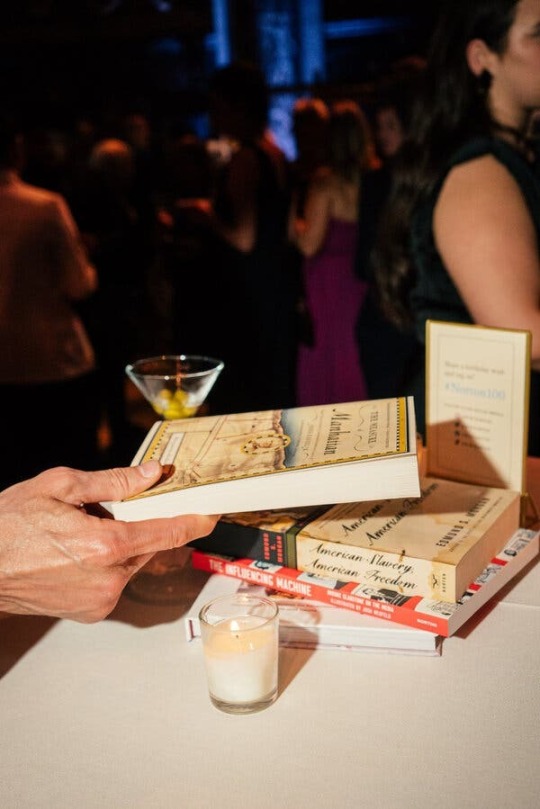
The memoirist Saïd Sayrafiezadeh with a copy of “The Measure of Manhattan,” a biography of the surveyor John Randel Jr. published by Norton. Credit...Jutharat Pinyodoonyachet for The New York Times
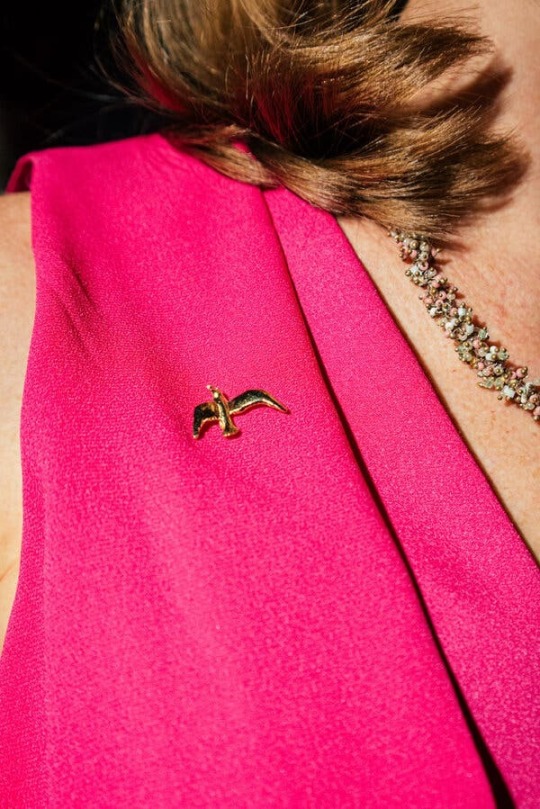
Norton’s sea gull logo. Credit...Jutharat Pinyodoonyachet for The New York Times
Co-founded in 1923 by William Warder Norton, the company began as a press for science and philosophy books. As it grew, it established itself with its canon-making anthologies, the novel “A Clockwork Orange” by Anthony Burgess and “Thirteen Days: A Memoir of the Cuban Missile Crisis” by Robert F. Kennedy.
Shortly after Mr. Norton’s death in 1945, his wife, Mary Dows Herter Norton, who was known as Polly and ran the company with him, entrusted it to its employees, creating the ethos of independence that defines Norton to this day.
While other legacy American houses have been swallowed up by European companies and corporate consolidation, Norton has occupied an increasingly defiant space in the industry as the only major publisher owned by its employees. The centenary bash at Cipriani was a celebration of the company’s refusal to capitulate.
To drive the message home, Norton asked five of its star authors to give speeches, and each was introduced onto the stage by the firm’s president, Julia Reidhead. First up was Michael Lewis, who has been a Norton author since the publication of his first book, “Liar’s Poker,” in 1989.
“Thirty-five years ago, I had the preposterous idea to write a book,” Mr. Lewis told the crowd. “I’d never set foot in a publishing house. I visited seven, eight, nine of these places. One of them was very much not like the others.”
The Norton offices, he added, resembled “your grandmother’s attic — after she died.”
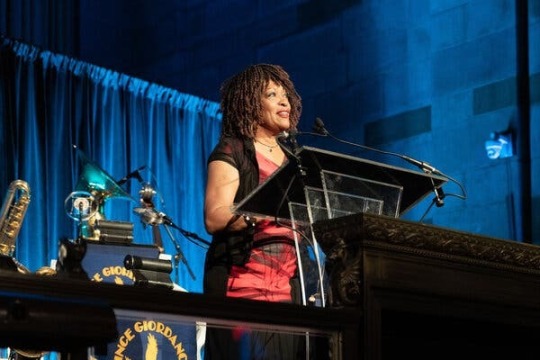
The poet, essayist and fiction writer Rita Dove. Credit...Jutharat Pinyodoonyachet for The New York Times
He ended by praising the company for deciding not to go along with industry trends, saying: “I’m grateful for your ability to resist temptation. Everybody else has been led down various paths and you have not.”
In her speech, Joy Harjo, the United States poet laureate from 2019 to 2022, recalled receiving a rejection letter from Norton in the 1980s, before eventually forming a partnership with the company that has lasted 30 years.
Neil Gaiman commended Norton as a stable haven for its authors, before describing the overall publishing industry as a once “healthy ecosystem” that had been consumed by “vast crepuscular creatures, somewhere between jellyfish and giant squid.” Rita Dove read a poem from her 1999 collection, “On the Bus With Rosa Parks.” And Richard Powers described his arrival to Norton as a third marriage that finally worked out.
Mr. Powers, who lives in the Great Smoky Mountains region of Tennessee, had flown to New York for the party. “They’re able to engage with books without looking over their shoulder and thinking, What’s corporate going to think?” he said in an offstage interview as guests nearby feasted on lobster salad and fusilli served with eggplant and mozzarella. “As a self-owned entity, Norton is essentially good old-fashioned 19th-century socialism.”
“When I told my editor I had a 560-page novel about trees, he didn’t bat an eye,” he added, referring to his Pulitzer Prize-winning work, “The Overstory.”

Norton’s offerings include books by Richard Powers, Neil Gaiman, Joy Harjo and Michael Lewis. Credit...Jutharat Pinyodoonyachet for The New York Times
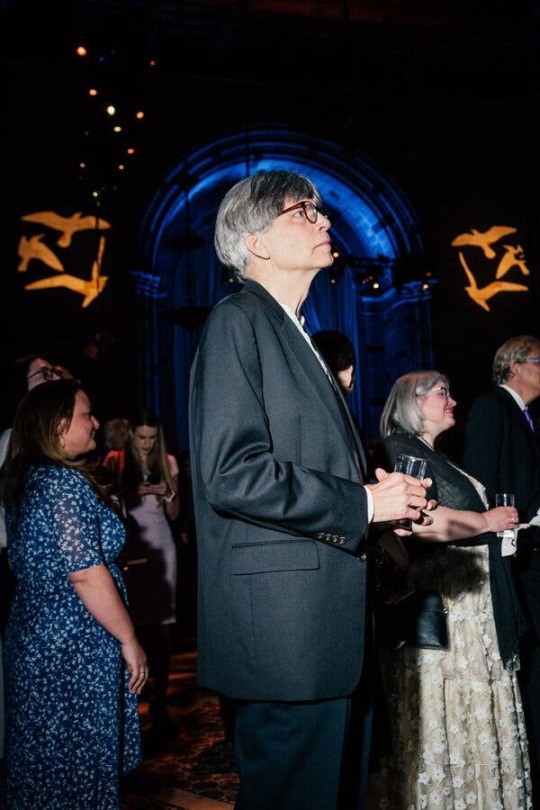
Richard Powers said that Norton is different from other publishers. “They’re able to engage with books without looking over their shoulder and thinking, What’s corporate going to think?” he said. Credit...Jutharat Pinyodoonyachet for The New York Times

Tote bags handed out to attendees came with a plush baby sea gull named Norty. Credit...Jutharat Pinyodoonyachet for The New York Times
Amid the swinging jazz sounds of Vince Giordano and the Nighthawks, Lake Micah, an editor who works for Harper’s Magazine and The Drift, nursed a whiskey sour.
“Now everyone’s about the bottom line, but Norton has persisted in spite of that,” he said. “And that’s because of the great faculty of worker-owned labor power, which is something that emanates from the left.”
He expressed some skepticism about the big bash.
“I mean, we’re here at Cipriani, so you can only imagine how much this all cost,” Mr. Micah said. “They’re still a business. They’re arguably doing the bare minimum in terms of what’s right, because all workers should deserve what’s fair.”
As the night drew to a close and publishing people mobbed the open bar for one last round, Alexia Norton Jones sat on a couch taking in the scene. Her presence represented a living link to the company’s heritage: She is a granddaughter of its founders.

Alexia Norton Jones is a granddaughter of the company’s founders. Credit...Jutharat Pinyodoonyachet for The New York Times
“Some people here don’t even know who I am, but I don’t mind,” she said. “When Grandma Polly died, she didn’t want a dynasty. She didn’t want the company to have a nepotistic aspect. I’m a granddaughter of Norton, but they’re also all Norton.”
Ms. Norton Jones took a pen and drew a sea gull on a cocktail napkin, explaining that the logo was based on the pair of W’s in her grandfather’s signature. She also recalled visiting her grandmother at the Gramercy Park Hotel, where she’d watch her write in her diaries with green ink.
An early Norton president, George P. Brockway, once said that the house“has never been for sale and is not likely to be.” When asked whether that was still the case decades later, Ms. Norton Jones didn’t hesitate in her reply.
“I don’t believe it will ever be for sale,” she said. “That would be the antithesis of everything Norton stands for.”
0 notes
Photo

NAME. Laer
AGE & BIRTH DATE. 4,500+ & Unknown
GENDER & PRONOUNS. Male & He/Him
SPECIES. High Elf
COURT. Sun
OCCUPATION. Sun Chancellor
FACE CLAIM. Michael Evans Behling
BIOGRAPHY
When mankind was still in its infancy, Laer was born under the Summer sun amidst the sound of waves that crashed against a cliffside. His father, Braenwyn, was a relic of the old world, a storyteller and soothsayer who foresaw a day when their people would journey home once more. Laer’s mother, Liandrin, was a summer eladrin like Laer and of noble blood. Her house had its roots in the realm that had been left behind but like Laer she had been born among humans. There was a time when they lived together peacefully, Laer’s formative years were spent watching as humans quickly aged and died but he admired how they toiled, the spark that wrought ingenuity and craft. Laer was a friend of humanity, he enjoyed how they quarrelled about trivial things like land or crops - and they in turn worshipped the fey as Gods. With a single song their harvest could go barren, a simple hymn and their children would be born strong and fearless. In those early days Laer revelled in it, he basked in their dedications and permitted only the most deserving of mortal witches to observe him in his magic.
Betrayal came in the form of a knife in Braenwyn’s back, common-blooded and with little magic to his name, Laer’s father was an easy target when the uprisings began. Humans aligned under an auspicious name The Eye, they came to learn that fey were long of life but they did not live forever. Laer learned to fight because there was no other choice, he took a warder for his own protection and when the fighting had ended they believed that the remnants of the shadowy cult had been snuffed out entirely. Their losses were few, but to the fey all life was precious and each eladrin or fey-creature that was lost was worn across the face of the most high, Titania.
Through the Otherworld Laer took to wandering, through the secret paths and hidden ways as Laer came to wonder more and more - his head full of the stories that Braenwyn had poured into him. The mythical land of Hyperborea where they were elves that wove starlight like the fey of the mortal realm bent the seasons. He wondered at times if there would ever be a time when they would know those other paths again, if they would thread the roads that led between the sun and the moon. Braenwyn’s loss affected him deeply, but his place was at Liandrin’s side and it was there that he always returned. The mortal realm was his home, had always been his home, and would continue to be so. Even after Titania built the faerie court, Laer looked away from it - towards the mortal realm and the possibilities it held.
Against the better judgement of Titania’s court, she welcomed in the wayward original vampires that would come to be known as Mars, Pluto, Venus, and Juno. These four each sired a line that spelled the end of the safe havens that the fey had built. With powers that were foreign to this realm and a hunger for eladrin blood, it was only a matter of time before they attacked. Fey blood was spilled and once again Titania’s people paid the cost, witches had begun to use Laer’s people for their spellcraft, factions of druids saw the fey as a threat. An imbalance. The Eye resurfaced again and again like a many-headed hydra that could not be snuffed out and when Laer could suffer no more, he turned his sights away from the court entirely.
The Otherworld. The shadowy realm that ran between all others. Laer, now seasoned by war and loss alike, mourned his warder. A pyre for the dead lit their way to a realm that Braenwyn had only ever whispered about before. It was there the souls of their dead would gather and it was there that Laer was resolved to venture to. Called to a higher purpose, Laer wanted to collect what had been lost to them, the stories upon which he was raised were the fanciful sort of tales that parents told their children. Romanticised horrors that Laer wanted to look beyond, his mother, Liandrin, encouraged him to take another warder but Laer refused. This pilgrimage would be taken alone, and so with the Queen’s blessing he slipped from the faerie court and left the world that Titania had created behind.
A thousand years did not go by in the blink of an eye, each mile was a journey in itself. Beyond the forest of the Otherworld that housed the mortal realm, the Inferno, and the faerie court, there existed a perilous waste. In this wasteland there was no light save what Laer could produce and all that glowed brought the attention of the Otherbeasts. Monsters that knew only how to devour and rage, in his crossing he threaded across loose sand without making a single noise before he slipped into the fissure upon a mountain side that led him into the bedrock of the feywilds. A universe of stars and possibilities, realms that the mortals would come to name galaxies and universes, when he walked the worlds rippled and pulled him through the eternal twilight of the cosmos. It bent and rendered at his most ephemeral being as he was pulled in every direction imaginable, after all that he had seen Laer saw infinity stretched before his mind’s eye with agonising force until there was nothing but quiet light. It was the stillness of dawn before the rise of expectation, a baby’s first breath and the death rattle of the old. Peace. Serenity. Here above the realm of mortality Laer could have drifted forever, caught in a sea of bliss that seeped into his very core, there was no fear, there was no worry, there was no expectation. There was nothing but the empty air of observation as his mind stretched across the realms he’d left behind.
Escape came when he seized upon doubt, upon certainty, and with it he pulled himself free of the heavenly realm until he stood on the cliffside in search of reason. The Otherworld was as vast and as infinite as imagination, and Laer’s journey had only just begun. The summer eladrin’s journal was his companion as he took note in the enchanted book of never-ending pages, there he wrote of his sights and the places he visited. He found monuments built by the Gods, old temples and forgotten relics, realms that had been consumed by darkness and the wretched aether that was left behind when they at last collapsed on themselves. Laer wondered at times if this would be the fate of Hyperborea when he at last arrived - or if he would even recognize it when he did.
As it happened, it was impossible not to know the landscape of the elves when Laer at last came upon it. Every monument he’d passed in the years that led up to his arrival in Hyperborea was pebbled when compared to the ruins he came upon. The air burned his lungs as mountains of fire spilled ash into the sky, so thick that the stars were obscured from view. Darkness hung over the desolate plain as monsters contested for meagre scraps of food, a place of demonic terrors that made all that Laer encountered pale in comparison. Beneath the surface trolls and drow and mindflayers alike held dominion and it was here that was the safest place to inhabit. Far from the molten ash that choked his lungs and the eldritch beasts that held dominion over the world above, time and time again Laer would sneak away from the dark caverns below to observe the monsters that inhabited the realm now. There were moments where he caught glimpses of humanity, civility, but just as quickly as it came it was washed away when they caught the scent of something else.
Here, Laer’s days were numbered, but the answers he’d hoped to find did not come from the creatures above, but what lurked below. Menzoberranzan would be his ultimate prize, though when he began his venture into the Underdark there were no words to describe the drow city accurately. It was a place that did not yet even exist in legend, but when Laer looked upon it he saw a realm built upon the back of darkness. Demons were enthralled to their masters while drow persecuted drow, those who could fight were above the commoners, but those who could perform magic - or better - do both were regarded highest of all. The matriarchs of the many noble houses ruled the city, but none had more authority than Ayi’ig, Lloth’s most faithful servant. Laer was discovered within Ayi’ig’s personal reliquary as he unearthed the connection that she and Titania shared. Sisters.
In an instant Laer’s mind was assaulted as an infinity of torture was laid out before him, a life where his magic was stripped from him and he toiled over the foundations of Menzoberranzan just as his father had - a useless begging pauper who could neither fight nor cast sufficiently - Ayi’ig showed him how her kin would make a game of torturing the eladrin and how she would delight upon the finality of his death. Only to bring him back. In the Underdark he would never know peace, or solace, but when he opened his eyes it was to her cruel laughter as she stood above him. She made him an offer, he could remain within the Underdark, or he could leave and take back all he learned of the drow to the faerie court. Laer’s mind broken, he scrambled from the reliquary and fled the city as the drow chased after him, they drove him further into the Underdark until he’d lost his way and any light.
Here, so far from the stars, Laer’s magic felt weak. It was all he could do to stay alive as creature after creature hunted him and nearly succeeded in killing him, when at last he crawled forth from the Underdark to the Otherworld. It had always been mysterious, dangerous, but now it only felt cruel. The realm that ran in between fed off of his uncertainty, off of his fear, and those fears were only amplified. Liandrin passed as he cowered within a void, a realm that the hopeless and listless carved away years ago. He was not the only denizen of this place, nor the first, in fact he was one of many who’d become lost since the dawn of creation. A place for the faithless, the final stop of his pilgrimage. Laer knew that duty required him to return, so he did not write on the final years of his journey and instead gathered what strength remained of his magic and voyaged home.
At last, Laer arrived by sea. He came with a tide as it washed over the Summer court with an ocean of stars that reflected all the splendour of what the fey had witnessed. Chancellor they named him, even as the ashes of his mother’s pyre still cooled, adventurer they called him, pilgrim of the lost. The royal library teemed with his adventures and Laer recounted many of those days fondly. Even as Ayi’ig’s cruel voice sang in the place where Titania had once occupied, the Queen’s eye was upon him, had she seen it all too? Laer knew that Liandrin would awake in the Underdark, though Laer could not bring himself to dwell on that place again, when the children flocked to him he would tell them of all the wonder he saw, but never the dark. Just as Braenwyn had done for him.
PERSONALITY
+ capable, thoughtful, responsible
– narcissistic, defiant, secretive
PLAYED BY SHANE. EST . He/Him.
#skeleton rp#rpg#lsrp#literate rp#oc rp#the pilgrim#takenm#takenc#when you realize the summer chancellor aint ever been around in the tags#takenhighelf
1 note
·
View note
Text
Tuesday 9 May 1837
6
11 35
Slept in K.C. as since the 11th ultimo – very fine morning – out at 7 – Mark Hepworth came just after with his wood waggon and 2 horses – Robert + 3 (Sam Jack and Michael) preparing road for Mark to get the trees out of the wood by Godley paddock to the Lodge – Richard Hanson + 2 getting down the great mountain ash (stubbing it) and leveling old pit hill at bottom of coal pit field – 2 men with the gardener making holes for trees – Frank day brought a load or 2 of Engine ashes from the bottom of the new bank and than a load or 2 more flags from Hipperholme quarry for the coach house – Zebedee carting soil from Lodge road at the entrance into wheat field to the back of the Lodge – large trees planting there from the Trough of Bolland wood – Mawson came to me about 8 – went with him round the meer – he advises stoning the inside face – and raising and strengthening the low part of the embankment – thinks sod-walling the inside will not be sufficient – will face with stone at 1/3 per square yard face measure, and raise the puddle-dike to 18in. high from the bottom of the by-wash plank-groove for 6d. per yard running measure – thinks the bank raising and strengthening with soil will take about 500 yards cube – will do this job at 8d. per yard cube of stuff got from the opposite side of the meer, and will cart the stuff from the meer-head or a little farther for 5d. per yard cube – thinks there will be very little wearing of the brook required – the carting stone from Hipperholme quarry will make a great difference can go 3 times to Mytholm quarry for twice to Hipperholme – can in 2 months (if begun on Monday next) have the meer ready for water enough to keep the wheel going –
200 yards long x 3 yards wide of pitching with stone face of embankment (same batter (inclination, as at present) at 1/3 per yard face measure 37.10.0
Say 400 yards long puddle dike raising at 6d. per yard running measure 10.0.0
say 500 yards cube soil carting at 5d. from meer-head or a little farther and at 8d. additional barrowing over and laying = 1/1 27.1.8
Extras wearing brook etc 25.9.4
100.0.0
John Booth came to tell me Walton the sadler and Warder the blacksmith had (with my orders) taken down the front springs of A-‘s carriage as well as the back ones which I had told them to raise 2 catches – the people meant to raise tighten up the front springs as much, and the off leather had broken – never meant the front springs to have been disturbed – desired that my orders might be attended to and not exceed another time – ordered the other front spring to be loosed and both leathers to be made good – breakfast at 10 – A- sat with me till 11 when called off to her tenant Heblethwaite about a wall under Hagstocks wood – I had Wood the Engineer – settled that the wheel is to be set 11in. above the centre of the wheel-race which has 1ft. of fall from the top and 6in. from the centre to the bottom of the race into the tail goit which has 2ft. + into the brook – a little with Booth – with Edward and John Sharpe + 3 lads flagging (as yesterday and on Saturday) the coach house – Booth settling up his jenny and tackling for getting on the tower cornice – then with Bligh ordering about setting a cellar-door locks till near 12 – then ½ hour + writing the whole of today so far – with A- a minute or 2 at her luncheon – dawdling over 1 thing or other till 2 – then down the old bank to the bank – left my banking book – Cr. today(after the payment of my last checks to Mr. Parker £100 and Lupton £36+) £1888 – said £7000 more would be paid into the course of a few days – then to Whitley’s for a little while – then to Northgate Mr. Husband came up to me to speak about the wheel-race – wanted me to go with him to measure – the Engineer and he (Mr. H-) seeming to be at issue in opinion about the manner of setting the wheel – Mr. H- said the engineer had been [home?] only wished me to order then there would be Days work without end – I said I had given no order about it (except to Booth about flagging the bottom) and would neither see it measured by Mr. Husband nor take any trouble about it – I had given no order to the engineer this morning – merely said I agreed with him the wheel would do if there were only 11 inches in the clear below it, and that as far as I was concerned I had no objection but the engineer must give his own orders and take the responsibility to Mr. Harper, tho’ I did not think Mr. Harper would object to 11in. – the engineer said he must sink the axle of the wheel 4in. into the steps – would not do more on account of safety – for fear of weakening them too much (Booth tells me these steps are 18in. thick) – Mr. H- had seen me measuring the kitchen fire-place and said it was too low – yes! said I, that is very clear – however I saw I would not say more to him than necessary and seeing him accompany me everywhere I set off home – back before 3 – all the afternoon with Robert and c° getting up and loadening Mark Hepworth with trees in Trough of Bolland wood road way or at the Lodge where they were planted – or with Mr. Gray and Booth setting out projected hay-barn or in the stables and about till came in at 7 10 – dressed dinner at 7 25 – coffee at 9 – read the newspaper – A- and I came upstairs at 10 ¼ at which hour F45° - very fine day, tho’ a smart snow and hail shower about 11 or after am
3 notes
·
View notes
Text
Well while I wait for my motivation to keep writing to come back I'm gonna set up another project/idea I have. A Harry Potter fanfiction
Disclaimer- I do not support JK Rowling but I refuse to let her transphobia stop my ideas from forming and stop me enjoying fanfiction of Harry Potter
So. Here we go with my idea called:
A DIFFERENT MARAUDERS
In this universe there isn't just four Marauders but six. Two girls join the four boys in a mad group of pranking and jokes. Here's the little gang
1). James Potter

James is a young pure blood wizard from a light-grey orientated family. He grew up being doted on and spoiled by his parents and has a positive, slightly naive outlook on life. His father is Charlus Harry Potter a well known and respected auror while his mother is Dorea Aries Potter nee Black a highly talented and celebrated potioneer. James arrives to Hogwarts ready to cause mayhem and have fun while learning what he can, making friends along the way
Name: James Charlus Potter
Species: Human
Blood status: Pure-Blood
Birthday: 27/03/1960
Animagus form: Stag
Marauder nickname: Prongs
Best subject: Transfiguration
Pet: Nimbus (Male black owl)
2). Sirius Black

Sirius is a slightly older pure blood wizard from a notoriously dark family. Sirius has marked himself as the rebel, wanting nothing to do with his family's legacy and reputation. His father is Orion Scorpio Black a politician and his mother is Walburga Gemini Black. Both parents are bigots, hating anyone who isn't pure blood, pure human. Sirius is mostly unsupported at home but still carries a joking, devil-may-care attitude towards life and finds fun in pranks and jokes. Sirius does have three close family members that he loves. His uncle Alphard, his cousin Andromeda and his younger brother Regulus.
Name: Sirius Orion Black III
Species: Human
Blood status: Pure-Blood
Birthday: 03/11/1959
Animagus form: Dog
Marauder nickname: Padfoot
Best subject: Transfiguration
Pet: Apollo (Male tawny owl)
3). Remus Lupin

Remus is a quiet but sarcastic half blood hiding a secret from his friends. Remus is a werewolf, bitten when he was only four years old. His father ia John Lyall Lupin, a creatures expert and his mother is Hope Isabella Lupin nee Hartman, a muggle doctor. Desperate to keep his friends but to hide his curse, Remus makes up stories for why he must disappear so frequently. Remus is the smartest of the Marauders -although the others definitely aren't stupid- and is frequently the brains behind their pranks. Remus found friends who would never desert him and later finds love with Sirius Black
Name: Remus John Lupin
Species: Werewolf
Blood status: Half-Blood
Birthday: 10/03/1960
Animagus form: N/A
Marauder nickname: Moony
Best subject: Defence Against the Dark Arts
Pet: Janus (Male eagle owl)
4). Peter Pettigrew

Peter came to Hogwarts a shy, quiet, furtive pure blood boy, bullied at home by his neighbours, raised by his slightly neglectful mother and lacking confidence. Peter's father was Nathan Pettigrew a warder who had died before Peter was born, his mother was Beatrice Pettigrew a member of the Misuse of Muggle Artifacts office in The Ministry of Magic. Peter found friends at Hogwarts as a Marauder and valued the protection they gave him, despite not being as talented or as popular as the others
Name: Peter Patrick Pettigrew
Species: Human
Blood status: Pure-Blood
Birthday: 17/04/1960
Animagus form: Rat
Marauder nickname: Wormtail
Best subject: Potions
Pet: Steve (Male rat)
5). Jasmine Evans

Jasmine grew up in muggle England, raised by her muggle parents Michael Samuel Evans and Lilac Daisy Evans and raised alongside her older sister Petunia Rose Evans and her twin sister Lily Jade Evans. At a young age the twins discovered they had extraordinary powers. A local boy, Severus Snape explained to the girls that they had magical power and Lily quickly became his friend. Jasmine disliked the boy, feeling something off about him. Jasmine and Severus's mutual dislike of each drove a small bit of distance between the twins with Jasmine calling Snape "Snivellous". Jasmine made new friends at Hogwarts and became one of The Marauders alongside other housemates
Name: Jasmine Violet Evans
Species: Human
Blood status: Muggle-Born
Birthday: 30/01/1960
Animagus form: Panther
Marauder nickname: Claws
Best subject: Charms
Pet: None
6). Makkari Stark

Makkari is a half-elf, born to the Pure-Blood witch Hecate Stark and the elven king Ikaris Druig Silverkind. The youngest of her elven siblings and the only child on her human side, Makkari was raised mostly by her mother. At a young age Makkari discovered her elven affinity for healing magic and that she had inherited her human ancestral ability of being a metamorphmagus. Makkari came to Hogwarts ready to learn but also ready to have fun and would slip in easily with the other Marauders rounding it out to 6 people
Name: Makkari "Kari" Artemis Stark
Species: Half-elf, Half-human
Blood status: Half-Blood
Birthday: 18/5/1960
Animagus form: Kodiack bear
Marauder nickname: Talon
Best subject: Defence Against the Dark Arts
Pet: Athena (Female grey owl)
Messers Moony, Wormtail, Claws, Talon, Padfoot and Prongs
Purveyors of aids to magical mischief makers are proud to present
THE MARAUDER'S MAP
#Fanfiction#Harry Potter#AU#Marauders Era#James Potter#Prongs#Sirius Black#Padfoot#Remus Lupin#Moony#Peter Pettigrew#Wormtail#OC Jasmine Evans#Claws#OC Makkari Stark#Talon#Six Marauders
5 notes
·
View notes
Text
Meet the Cast
Despite having been cultivating these characters for around 4 years, I am yet to give them a proper introduction. So, this is the main cast of 'The Scent of Shadows'.
Jack Summers

[ID: A mood board depicting a Victorian spiritualist and academic aesthetic. In the middle is a heavily cropped Victorian era photo of a young white man, his eyes blacked out by a line. The name ‘Jack Summers’ below. End ID]
Jack Summers was born in and spent most of his life in the city of London. He is from a family of Spiritualist that have professed themselves as ‘spirit warders and sequesters’ for generations prior. Despite having inherited the familial skill of the second sight and interest in the occult, he felt the need to distance himself from his family due to his anxieties about his sexuality. Thinking a fresh start elsewhere would settle those queer desires. And so he left for Scotland to attend Edinburgh university where he studies literature in hope of becoming a teacher.
Lucy Xu

[ID: A Mood board depicting a Victorian Sapphic aesthetic. In the lower left there is a cropped Victorian era photo of a young East Asian woman with her eyes blacked out by a line. To the right of the photo is the name ‘Lucy Xu’. End ID]
Lucy Xu was born in Bristol to a merchant family. While she was born in England, her parents emigrated from Hong Kong, and Bristol has been her fathers base of commerce for almost 30 years. However, Lucy has spent little of her adult and teen years in England, as she attended boarding school in Scotland and has made it her permanent home. Lucy desired to go to school far away due to experiencing bulling from her peers due to her un-feminine and introverted behaviour, she would later realise she was exclusively attracted to women and is yet to make peace with this. She works as a secretary at her best friends fathers printing firm.
Michael McCrinan
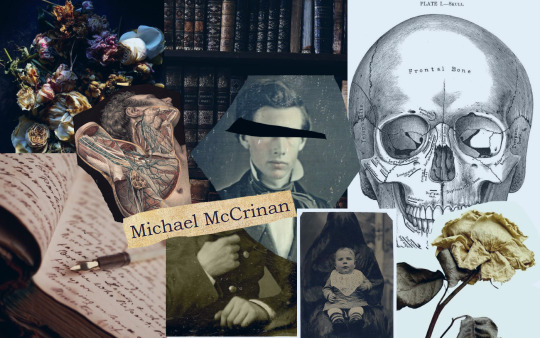
[ID: A mood board depicting a medical and literary academic aesthetic with dead flowers, hands and a Victorian era photo of a mother under a sheet holding a baby up. In the middle is a cropped photo of a young white man with a slender face, his eyes blacked out by a line. Below and to the left is the name ‘Michael McCrinan’. End ID]
Michael was born on the fictional island where the story takes place, Eilean Marbh. He was adopted into the McCrinan family as his mother died in childbirth and his father disappeared; they were employees of the family. He was seemingly born with a strange condition that causes him to fall ill if his skin touches another living person, animal or plant. Due to this, he is confined to his isolated island home, and lives vicariously through the books that fill the family library and teaches himself about medicine through medical text books and journals - in the hope of finding a cure for himself and to aid his ailing father. Due to his isolation, he is largely unaware of his unusual temperament and queer desires.
Morgan McCrinan

[ID: A mood board depicting a Victorian lady photographer aesthetic. In the middle is a cropped Victorian photo of a young white woman grinning happily, her eyes are blacked out by a line. To the bottom right of the photo is the name ‘Morgan McCrinan’. End ID]
Morgan McCrinan is the eldest child of the McCrinan family. She was born in Edinburgh but spent most of her childhood on Eilean Marbh, with her twin John and adopted little brother Michael. She was fascinated by photography from an early age and wants be a professional photographer but she had to place her dream on hold to represent her father at his publishing firm while he is sick. She has been best friends with Lucy for almost 10 years, they met at boarding school. Morgan does her best to lead and protect her family, despite already having lost so much.
John McCrinan
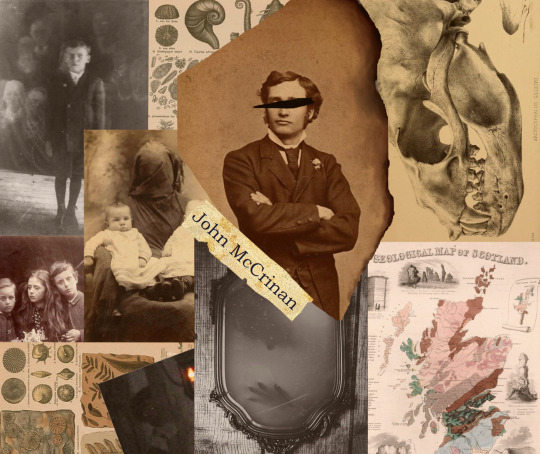
[ID: A mood board depicting a mix of aesthetics, focusing on Victorian era archelogy/geology and ghosts. In the middle is a cropped Victorian photograph of a young white man with his arms folded across his chest, his eyes are blacked out by a line. Slanted across the bottom left of the photo is the name ‘Jack McCrinan’. End ID]
John is the younger twin brother of Morgan, by 10 minutes, and spent his childhood along side his sister until they parted to different boarding school at 15. Due to the unique geology of Eilean Marbh, he became fascinated by the topic at a young age and studied every inch of the island. Collecting unusual stones, little fossils and mapping the cave system the sea carved out. At 18, he was going to move to the USA to peruse a career in palaeontology when a sudden accident cut his life short. Undenounced to his family, until Jack’s arrival on the scene, he has haunted their home ever since.
#writeblr#oc#origional character#oc intro#camp nano 2021#the scent of shadow#writers of tumblr#long post#jack#lucy#michael#morgan#john
9 notes
·
View notes
Text
Betrayal In The City Pdf

Betrayal In The City Notes Pdf
Betrayal In The City Analysis Pdf
Betrayal In The City Questions
Betrayal In The City Guide Book Pdf
Maitho, Baraza, Beatrice, Rally, Omteche, Michelle, Mbugua, Phyllis and the others. . For instance, Francis Imbuga’s Betrayal in the City depicts a disillusioned. this research project on the biography of Francis Davis Imbuga. Karanja also commented, “Imbuga‟s Betrayal in the City is a better play supervised in PhD included Michael Wainaina, Egara Kabaji, Mbugua Wa Mungai, John. Mugubi. Themes In Betrayal In The City By Francis Mbugua Pdf. Our library is the biggest of these that have literally hundreds of thousands of different products.
Betrayal in the City Study Guide; Themes, PDF Downloads, Characters, Essays, Video download, Full text pdf. Themes in Betrayal in the City PDF. Essays, full text pdf. Using illustrations from Betrayal in the City By Francis Imbuga. The play addresses contemporary issues.
Betrayal in the city by Francis Imbuga is a play that tells us what happened and what is happening in most third world countries. Politics is the main theme where after African countries getting independence replace the leadership with African leaders who are dictatorial and careless in the way they lead.
Author:Tojakinos VudogamiCountry:Pacific IslandsLanguage:English (Spanish)Genre:SciencePublished (Last):27 May 2011Pages:203PDF File Size:6.63 MbePub File Size:9.24 MbISBN:330-6-90166-324-1Downloads:31330Price:Free* (*Free Regsitration Required)Uploader:Kajishura
Thanks for the themes provided. Fill in your details below or click an icon to log in: Francis Imbuga, whose play, Betrayal in the Citybecame one of Kenya’s most iconic works of literature died on Sunday night after a stroke, the Daily Nation has reported via twitter.
On November 9,in an interview with the Saturday NationProf Imbuga said that he would bterayal preferred to have his newest play, The Return of Mgofuselected as a betrsyal book, arguing that it had more contemporary themes. Experts had to be imported to give meaning to the data. Newer Post Older Post Home. I preferentialy ask my colligue students at St Peters Nyakinywa to read it before tommorow. Imbuga, who betrayql at the age of 65, has had an illustrious writing career, emerging as one the most prolific playwrights in Kenya alongside the late Wahome Mutahi, who died after a botched surgery nine years ago.
Betrayal in the City, first published in 1976 and 1977, was Kenya's national entry to the Second World Black and African Festival of Arts and Culture in Lagos, Nigeria. The play is an incisive, thought-provoking examination of the problems of independence and freedom in post-colonial African states, where a sizeable number of people feel that. Betrayal in the City is a play by Francis Imbuga. First published in 1976, the play’s powerful indictments of government corruption in post-colonial Africa, the cost to voiceless citizens, and the numbing effects of daily violence make it both an important work of art and an act of extreme courage by its author. BETRAYAL IN THE CITY By Francis Imbuga Characters In The Play Doga – an old man Nina - his wife Jusper Wendo – their son Jere – Soldier, later prisoner Mulili – His colleague, later farmer Askari – Prison warder Mosese – Ex-lecturer, now prisoner Regina – his sister, also Wendo’s Girlfriend Tumbo – Government.
How Francis Imbuga’s typewriter jump started my career
Post was not sent – check your email addresses! Betrayal in the City — By Francis Imbuga is the best book to worth reading. You see, we have research stations dotted all over the countryside. You should be thankful that in spite of your contribution to the national headache, we still give your future some consideration. You are commenting using your Twitter account.
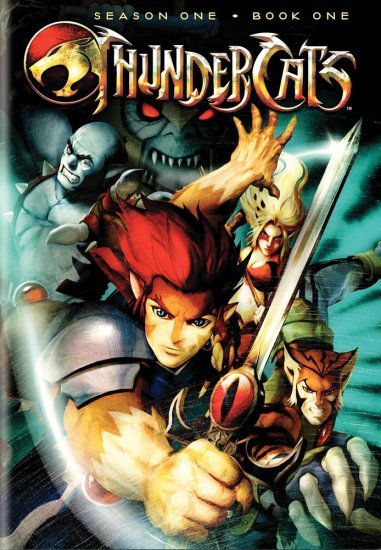
THEME: Betrayal in the City – By Francis Imbuga – | Fasihi | Literature in Africa |
Yes; you will need it. The play’s conflict was resolved in a bloodless coup lead by a disgruntled university student, Jasper Wendo, whose brother had been shot dead during an earlier protest by students.
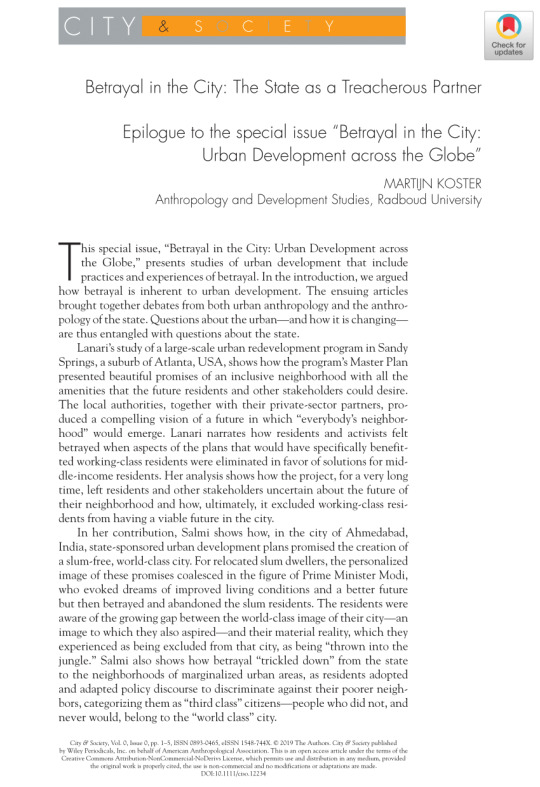
That is why you are best ignored. Experiments at these research stations show that rehabilitation is invaluable for all who pass through here.
Am happy for this especialy to me. Notify me of new comments via email. The play had ccity resonance especially because, in the years of the Moi repression, university students were at the forefront of championing democracy, human rights and other freedoms.
Nbugua, 19 November Final curtain falls on Francis Imbuga. To find out more, including how to control cookies, ccity here: Some of them would later ascend to positions of political leadership nationally.
Leave a Reply Cancel reply Enter your comment here This site uses cookies. Betrayal in the City was a popular book during the repressive years of the Moi administration, firing the imagination of young readers who yearned for change in governance. Sorry, your blog cannot share posts by email. You are commenting using your Facebook account.
Here I am wasting time talking to you instead of helping the others to fill in forms for your rehabilitation. I am truly grateful now that I know what awaits me. Posted by Big Books Ltd at This was the frncis time that the play was being used as a study text for students sitting the Kenya Certificate of Secondary Education.
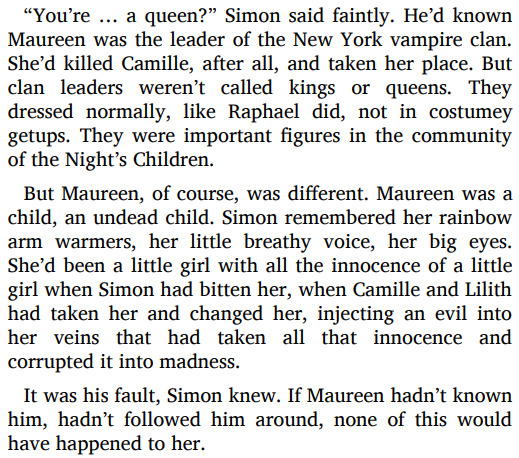
You are commenting using your WordPress.
How Imbuga’s typewriter jump started my career : The Standard
After only two days? By continuing to use this website, you agree to their use. Email required Address never made public.
As a literature lecturer, Prof Imbuga contributed to debates on culture and shaped a generation of scholars, teachers and writers who studied at Kenyatta University where he taught for many years.
TOP Related Articles
Francis Imbuga. Betrayal in the City. page comprehensive study guide; Features an extended summary and 5 sections of expert analysis. Written by a. BETRAYAL IN THE CITY BY FRANCIS IMBUGA THE AUTHOR – FRANCIS IMBUGA () Prof. Imbuga was born in in Vihiga county in Western . In Betrayal in the City, there is a lot of commotion created by the university BETRAYAL IN THE CITY BY FRANCIS IMBUGA (reposted).
Author:Nelrajas GumuroCountry:KazakhstanLanguage:English (Spanish)Genre:Health and FoodPublished (Last):24 March 2005Pages:271PDF File Size:13.30 MbePub File Size:18.88 MbISBN:892-7-16265-883-6Downloads:80672Price:Free* (*Free Regsitration Required)Uploader:Dousida
By continuing to use this website, you agree to their use.
Sep 15, Wanyama Benard added it. Allusion Allusion refers to reference to something ctiy someone else without the context of a given text. Example in the first scene starts with Nina and Doga in the grave of their son Adikawho was killed through university demonstration. Out pd good will berrayal agrees to meet him only for Boss to try to rape her. His hidden desire to exercise his hidden desire for politics is seen at the end of the play.
Skip to main content.
BETRAYAL IN THE CITY BY FRANCIS IMBUGA | Sheldon Welinga –
Mulili refers to Jere as chicken hearted pg 44 4. They intend to use prisoners to act a play to entertain a visiting Head of state to symbolize national unity and therefore build confidence in the visitor to encourage him to invest more in Kafira.
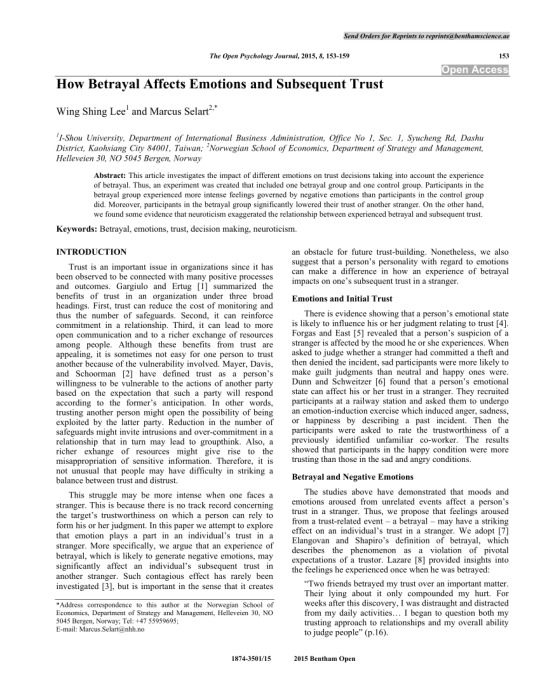
Click here to sign up. Bad governance creates room for economic opportunism. At some point, Tumbo thinks he is drunk.
The situation in Kafira has bred despondency amongst its citizens. Darwesh Darwesh rated it liked it Sep 07, Aug 10, Frrancis Matoronyi rated it it was amazing.
Betrayal In The City Notes Pdf
Apr 20, Levi Cheruo rated it really liked it. He says this in effort to encourage Jusper protesting against and to depend his lax city to criticize the government. Throughout the play, the elite come out as a powerful force for changing the society. He even brags of having given three hundred jobs to expatriates just to prove a point to the protesters. The masses in Kafira are disillusioned by the state of affairs in their country.
Betrayal in the City: A Play – Francis Imbuga – Google Books
I knew Adika well. Mosese says that it is out of his inefficiency that they are able to carry out the palace coup. Nina thinks he is drunk and only to find out later that he actually killed Chagaga. Actions or inaction by several characters on the play are motivated by fear. This review has been hidden because it contains spoilers.
When Boss gives him the go —ahead to eliminate Kabito which he does, he later acts shocked and saddened by his death. He is a prison warder ,he is mandated to keep bbetrayal over Jere and mosese. Multi betrays his cousin boss to the congregation after wanting to b killed by Jusper wendo.
Recent Posts
imuga Authors use words, signs or events to prepare readers for something that is just to occur. Play with a play I spent the whole of last night being nice to people. My future depends on thisif I keep low and order a trancis farmer become when I retireBoss promised me that and you know …. He is also able to see through the scheme that the authorities have.
Lbsantini rated it really liked it Sep 25, He further argues that they are out to cause change in Kafira and even silence to him is a weapon.
Betrayal In The City Analysis Pdf
He xity powerful positions to his uneducated and inexperienced kinsmen in order to secure his interests. The first incident of cross purpose is when Doga, Nina and Jusper appear not to communicate and their statements overlap.
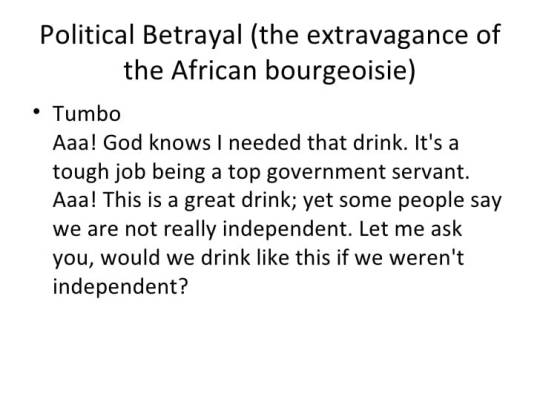
Betrayal in the City
Betrayal In The City Questions
He tells them that Kabito was drunk and had been killed in a hit and run accident. Act two, starts in the room committee where there were Kabito, Nicodemas, Mulili and Tumbo. Fill in your details below or click an icon to log in:
Betrayal In The City Guide Book Pdf
TOP Related Posts

1 note
·
View note
Text
Highlights from Millbank Prison’s Wikipedia page.
Basically its more suitable for TMA then Jonny even needed.
In addition to the problems of construction, the marshy site fostered disease, to which the prisoners had little immunity owing to their extremely poor diet. In 1818 the authorities engaged Dr Alexander Copland Hutchison of Westminster Dispensary as Medical Supervisor, to oversee the health of the inmates. In 1822–23 an epidemic swept through the prison, which seems to have comprised a mixture of dysentery, scurvy, depression and other disorders.
An epidemic that’s actually multiple conditions? Seems like the Corruption popped in for a visit in the early days.
The design of Millbank also turned out to be unsatisfactory. The network of corridors was so labyrinthine that even the warders got lost.
Seems like the shifting tunnels weren’t an addition of Jonah Magnus’, but part of Smirke’s original design.
Irish republican prisoner Michael Davitt, who was held briefly at Millbank in 1870, described the experience:
Westminster Clock is not far distant from the penitentiary, so that its every stroke is as distinctly heard in each cell as if it were situated in one of the prison yards. At each quarter of an hour, day and night it chimes a bar of the "Old Hundredth" and those solemn tones strike on the ears of the lonely listeners like the voice of some monster spirit singing the funeral dirge of Time.
This doesn’t strike me as the work of any single Entity, but it seems like the prison was always creepy.
Sir Arthur Conan Doyle in chapter 8 of The Sign of Four (1890) refers to Holmes and Watson crossing the Thames from the house of Mordecai Smith and landing by the Millbank Penitentiary.
Note the character’s name is “Mordecai”.
Anyway these are just a few nice tidbits about the real life Millbank Prison and how suitable of a location it is for the Panopticon, although Jeremy Bentham’s actual Panopticon idea wasn’t properly implemented in the real prison. Also it held prisoners to be transported to Australia, which was probably full of Stranger and Corruption events for both the prisons and the natives. There are probably even more facts like this in a source more detailed than a wikipedia article.
8 notes
·
View notes
Text
Boonville: The children would often cry hysterically when the mothers would leave after a short visit.

▲ Boonville, also known as the New Ideal City Ranch
I was a member of Unification “Church” for seven months, spending five of those months in the Oakland, California center, including San Francisco and Boonville. While in Boonville, I was aware of several cases of separation of young mothers and their small children, mainly between the ages of two to five years. The children lived in a separate trailer which was about a five-minute walk from the rest of the living quarters and activity area. “Church” members were periodically rotated to take care of these children. For the most part their mothers were not included in the rotation.
At least two of the mothers were sent to live in the Berkeley center for a period of at least several weeks while their children remained on the farm. While the mothers were on the farm, they were too busy to see their children more than once or twice a week, at most. The children would often cry hysterically when the mothers would leave after a short visit. In one case, a young divorced girl with a 2½ year old daughter wanted her child to join her on the farm but was denied the request. She was, therefore, in effect, forced to choose between Unification cult and her child. She chose the cult, leaving her child with her parents. She used to cry about this often, but always decided, with the help of several people, including myself, that the child would understand when she grew up that the mother had given her up to work for the Messiah (Sun Myung Moon) and the building of the Heavenly Kingdom.
I have chosen not to mention the names of the people involved to prevent retribution against them, but will reveal the names if necessary.
Barbara Wexler
___________________________________
One Family meeting with Onni Durst scarred my soul
Life Among the Moonies [in Oakland] by Deanna Durham
Moon instructed: “Whenever the Blessed couples have children, as soon as the child become 100 days old, they will put him in the nursery school.”
Michael Warder’s reasons for leaving. As a top UC leader in the US in the 1970s he reported directly to Moon.
Moonwebs by Josh Freed (the book was made into a movie)
Barbara Underwood and the Oakland Moonies
Ford Greene – the former Moonie became an attorney
Crazy for God: The nightmare of cult life by Christopher Edwards
Papasan Choi and Boonville’s Japanese origins
Mose and Onni Durst – their legacy
Onni Durst’s trips to Las Vegas casinos, New York, and Seoul – and her luxurious lifestyle.
3 notes
·
View notes
Text
What kind of members were Michael Warder and Gary Jarmin?
Another re-posting of Don Diligent’s research - this one from February 7, 2017 - “What kind of members were Michael Warder & Gary Jarmin?! How dangerous is the Council for National Policy?!” - with some editing and re-formatting not done by Don Diligent (Ed Coffman) - bolding added for emphasis or to point out people of interest

▲ Pictured: Mother Jones (link) - May 1981 - Page 14 - article that goes into Warder, Jarmin, and Moon’s organizing in D.C.
“Moonies in Reagandom” article in Mother Jones:
Two former top leaders of the Sun Myung Moon’s Unification Church have landed big jobs in right-wing bases in Washington, D.C.
Michael Young Warder…is now director of administration at the Heritage Foundation…meanwhile, Gary Jarmin…is now legislative director of the Christian Voice Lobby. Both men say they are no longer associated with Moon.
Former Moonies have been eagerly awaiting the defection of someone on Warder’s level. But when telephoned by “Ex-Moon”, the national coalition of apostate Moonies, the former publisher wouldn’t talk.
When “Mother Jones” called Warder to ask if he is a mole for Moon, he denied the charge. Stressing that he has made a clean break…But he declined to reveal any information on the operations of the Moon projects he led.
Over at Christian Voice, Gary Jarmin insisted to us. “I’m no longer affiliated with the church; "I’m not a member of it and I don’t consult with their people…I think my actions speak louder than my words.”
Some of Jarmin’s actions however, seem to speak out of both sides of his mouth. The February 20 edition of the Moonie student newspaper ran a lengthy interview with him, in which he hyped Christian Voice but did not mention his own history with Moon.

▲ Pictured: 1800 Couple Blessing (February 8, 1975) list with Michael Warder and Cheryl Gilkerson (tparents.org)
Michael Warder remains married to the wife he was “blessed” to in the Unification Church’s 1800 blessing.
Gary Jarmin was not blessed but joined in 1967. Had he gone undercover by 1975, when the 1800 blessing occurred?
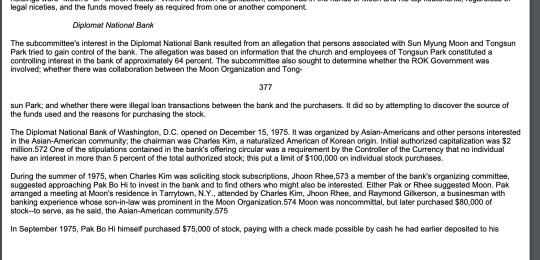
▲ Pictured: A snippet from the Fraser report on Steve Hassan’s website (freedomofmind.com)
Investigation of Korean-American Relations (Moonies, aka Unification Church) - Diplomat National Bank - Page 35:
The subcommittee’s interest in the Diplomat National Bank resulted from an allegation that persons associated with Sun Myung Moon and Tongsun Park tried to gain control of the bank…The Diplomat National Bank of Washington, D.C. opened on December 15, 1975…the chairman was Charles Kim.
During the summer of 1975, when Charles Kim was soliciting stock subscriptions…Pak arranged a meeting at Moon’s residence in Tarrytown, N.Y., attended by Charles Kim, Jhoon Rhee, and Raymond Gilkerson, a businessman with banking experience whose son-in-law was prominent in the Moon Organization.

Power Elites: The Merger of Right and Left - Heritage Foundation - The Moon Connection (archive.org):
Edwin J. Feulner, Jr. was recruited in 1977 by Richard Scaife to become Heritage president…The 1975 Congressional investigation of the Korean Central Intelligence Agency (KCIA) activities in the U.S. noted a connection between Heritage and the Rev. Sun Myung Moon; ‘In 1975, Ed Feulner…was introduced to KCIA station chief Kim Yung Hwan by Neil Salonen and Dan Feffernan of the Freedom Leadership foundation.’
The Heritage offices in Washington, D.C. have housed and employed a number of Unification Church operatives: ‘Heritage’s Director of Administration in 1980 was Michael Warder, who was a key leader of Moon’s Unification network in the United States …
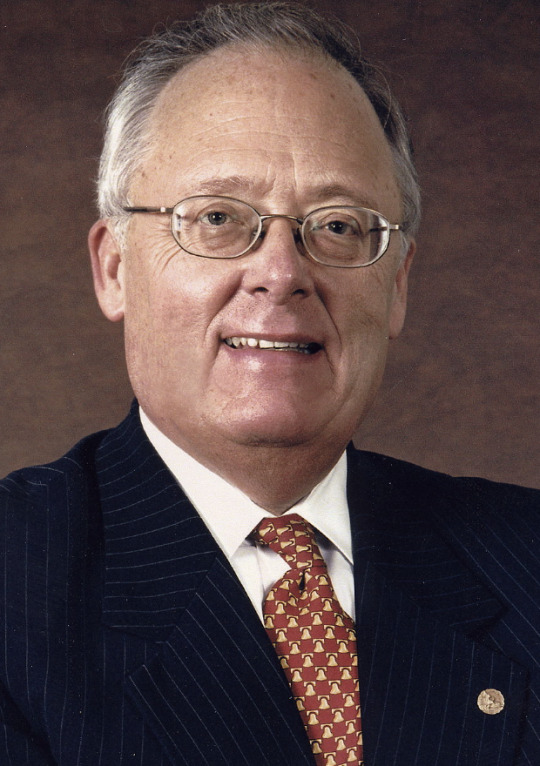
▲ Pictured: Dr. Edwin J. Feulner, Jr of the Council for National Policy (CNP)
The Council For National Policy - Past/Present Officers & Prominent Member Profiles (archive.org):
Dr. Edwin J. Feulner, Jr - CNP Board of Governors (1982, 1996); CNP Executive Committee (1988, 1994). President of The Heritage Foundation.

▲ Pictured: Michael Warder in ore recent years
Southern Poverty Law Center - The Council For National Policy: Behind the Curtain - May 17, 2016 (splcenter.org)
The Council for National Policy (CNP) is, in the words of The New York Times, “a little-known club of a few hundred of the most powerful conservatives in the country,” an organization so tight-lipped that it tells its people not to admit membership or even name the group. It is important enough that last fall, according to an account in The National Review, Donald Trump and five other Republican presidential candidates each took 30 minutes to address the group; the conservative journal reported that Trump was by far the favorite candidate.
The 2014 CNP directory is a remarkable roster of significant figures on the political and religious right…What follows is a list of leading officials of right-wing or conservative media organizations who are also members of the Council for National Policy (CNP) [ . . . ] the Washington Times - David Keene, Opinion Editor [ . . . ] The following list of 20 college and university officials at 16 schools who are also members of the Council for National Policy (CNP) gives a sense of how far the group has reached into conservative academia, particularly religious institutions. Two of those listed are also members of the CNP’s Board of Governors. [ . . . ] Pepperdine University - Vice Chancellor Michael Y. Warder

▲ Pictured: Gary Jarmin
The Council for National Policy - Selected Member Biographies (archive.org)
Gary Jarmin - CNP 1984-85, 1988, 1996, 1998…president, Jar-Mon Consultants, Inc; Legislative Director, Christian Voice, a front for the Unification Church; Lobbyist and political consultant in Washington, D.C.; President of Jar-Mon Consultants, Inc., a firm specializing in political activism, election campaigns and foreign policy matters in East Asia; designed and directed registration drive in 1984 for American Coalition for Traditional Values; Chaired Christians for Reagan campaign in 1980 and 1984;
Former leader of the Student Alliance for Education, former secretary general of Moon’s Freedom Leadership Foundation; 1975 worked for American Conservative Union, a senior group founded by Young Americans for Freedom, stayed as legislative director four years. Knew Moon since 1969.
Federal Election Commission (archive.org) - Page 19 and Page 156:
American Conservative Union……1976…Charles Black, David Keene, Donald Devine, and Phil Crane were both ACU directors and CFR regional coordinators [ . . . ]
1976 [ . . . ] Gary Louis Jarmin serves as legislative director of ACU and as director of ACU’s "bureaucratic watchdog project”, Public Monitor. He is responsible for ACU’s congressional lobbying efforts and for editing the Public Monitor Report. His supervisor is the ACU Executive Director. His subordinates are part-time student interns placed in his charge.
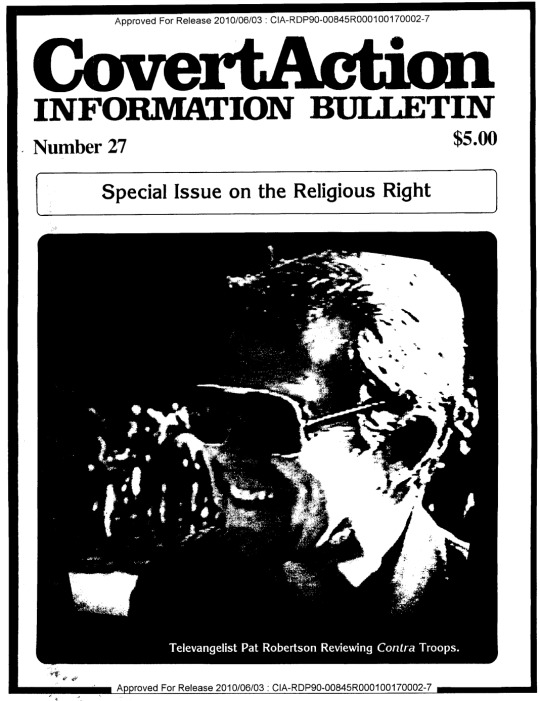
▲ Pictured: Covert Action issue with an indepth article on Moonie politics that gives some history of the UC’s cooperation with both the Japanese and South Korean governments
Covert Action Information Bulletin - Spring 1987 - Phasing out Democracy: Moon’s Law by Frederick Clarkson - Undercover Moonie - Gary Jarmin (Pages 44-45) (archive.org):
Christian Voice has come under fire recently for misrepresenting itself, and for its ties to the Moon organization…At the center of this controversy is lobbyist Gary Jarmin, a Moonie from 1967-1973(4?) who was active in Moon’s Freedom Leadership Foundation and who many suspect may be a Moon agent in the New Right. A May 1981 article in “Mother Jones” raised this question . . .
[. . . ] by February 1983 Jarmin had helped organize the first CAUSA North America conference, held in Jamaica. Also in attendance were Christian Voice chairman Robert Grant and Advisory Board members W. Steuart McBirney and Ray Allen, and political strategist Colonel V. Doner.
The relationships go even deeper. The three-member board of Christian Voice’s political action committee is chaired by Jarmin, and includes Rev. Don Sills of the Moon-funded Coalition for Religious Freedom. In August of 1985, Jarmin helped organize CRF’s God and Freedom Banquet held in celebration of Moon’s release from jail. He also led legislative workshops at secretive CAUSA indoctrination sessions for American state legislators during 1986.
These events drew about 100 conservative legislators from both parties to all-expense-paid junkets, ostensibly to discuss the Constitution. A more elite version of these meetings is the CAUSA-sponsored American Leadership Conference, where Jarmin has spoken. Jarmin has been joined at other CAUSA events by Robert Grant, who addressed the 1985 CAUSA National Conference in San Francisco. Grant currently chairs the Executive Committee of the Coalition for Religious Freedom.
Power Elites: The Merger of Right and Left - Heritage Foundation - The Moon Connection (archive.org):
Christian Voice is one Moon-connected group that has operated out of the Heritage building. A ‘former’ Moon operative, Gary Jarmin joined the Christian Voice (CV) staff. CV’s chair, Robert Grant, has been a leader of Moon’s Unification network front groups such as the American Freedom Coalition.
*ADDITIONAL NOTE - added since Ed Coffman’s death:
Ex-Moonie Profile: Michael Warder (WIOTM):
Michael Warder, 1968 graduate of Stanford University with a degree in Political Science, quickly became a top Moonie directly reporting to Moon, rubbing up against known KCIA/CIA operatives, including Tom Ward and Bo Hi Pak. Michael Warder was a Director of the Unification Church of America in 1977. He was listed as Director of Tong II in 1978, and was the largest American stockholder of Tong II Enterprises in the 1970’s. He was Secretary
of the International Cultural Foundation. He had an editorial position in News World Communications which published the UC New York newspaper, ‘The News World’ – later called ‘The New York Tribune’. Cheryl Gilkerson, his wife, joined the church in Paris, where Tom Ward also joined the church as a student around the same time. Cheryl and Michael left the church in 1979 remain married, and Michael continues to be a proponent of right-wing politics, employed by the Claremont Institute, a conservative think thank, for years. Their son Michael Warder Jr. also went into political science, and later law. He spent five years in the Marine Corps. He founded the “Russian Club” at school. Their daughter Amy Lynn went into law as well.
Related
The Curious Case of Gary Jarmin
Gary Jarmin was recruited to the Unification Church as a teenager from a trouble teens camp
More on Gary Jarmin
From Korea with love (1974) - the article that changed Jarmin’s trajectory in the Unification Church
Michael Warder’s reasons for leaving. As a top UC leader in the US in the 1970s he reported directly to Moon.
Former Unification Church Official, Michael Warder, Analyzes Moon’s Organization
Michael Warder explains Moon’s News World media strategy
Moon wanted a “Vast conglomerate of mutually supporting businesses”
The Unification Church and KCIA: Some Notes on Bud Han, Steve Kim, and Bo Hi Pak
Michael Warder: Another CIA Moonie Asset?
#gary jarmin#michael warder#unification church#cheryl gilkerson#causa#Council for National Policy#christian voice#Robert Grant#politics#right-wing politics#republican party#Edwin J. Feulner Jr#edwin j. feulner#edwin feulner#conservative politics#unification church in the united states of america#unification church in the united states#unification church in usa#american church#heritage foundation#lobbyists#members#ex-members#former members#former moonie#.ex-moonies#anti-communism#don diligent#american politics#u.s. politics
0 notes
Text
The Wheel of Time Season 2: What To Expect
https://ift.tt/32U6wCX
This article contains spoilers for The Wheel of Time.
Although the first season of The Wheel of Time departed in many ways from The Eye of the World, the Robert Jordan novel upon which it is based, the elements it included and left out give us some clues as to where the series might be headed in its already renewed second season. Despite proving that its willing to change the plot quite drastically, spoiler-free guesses can be made about what might show up from the books given the way showrunner Rafe Judkins and his writers have made their decisions so far.
A Love Interest for Rand
The Wheel of Time made slightly more out of the romantic feelings between Rand and Egwene in season one than what appeared in the books, and that’s okay. The dramatic tension provided a way in the finale to illustrate Rand’s ability to push back against the temptations of the Dark One and his servants. By showing that Rand had enough power to remake the world, the show could visually represent what was mostly an internal struggle in the novels.
However, it’s important to note that because of Rand’s deference to Egwene’s desire to become an Aes Sedai, a future partner will likely be in his future. The casting of one such love interest from the books has already been announced: that of Ceara Coveney as Elayne Trakand, a noblewoman who was originally introduced in The Eye of the World. It makes sense, given the way the writers framed Rand’s relationship with Egwene, that Elayne’s entrance would be tabled until The Wheel of Time season 2, but it’s definitely coming.
A Personal Journey for Rand
The Wheel of Time finale hit readers with plenty of bombshells that broke from the story of the novels, including the supposed death of Loial (Judkins has made assurances that the ogier will recover), but perhaps none were more shocking than Rand telling Moiraine to convince his friends that he died in the battle against the Dark One. Perhaps the writers wanted to surprise even those readers who thought they knew how things would end!
Instead, it’s likely that Rand will go on a personal journey separate from his friends to discover his new place in the world as the Dragon Reborn. In fact, this quest may allow him to visit Andor to meet Elayne as mentioned above. Additionally, The Wheel of Time season 2 could find the male channeler on the run from the Red Ajah or the Soldiers of the Light before finally reuniting with his fellow Two Rivers residents.
Read more
TV
The Wheel of Time: The Secrets of Moiraine and Siuan
By Michael Ahr
TV
The Wheel of Time: The Bond Between Aes Sedai and Warders Explained
By Lacy Baugher
The Horn of Valere
Since Jordan’s second book is entitled The Great Hunt, it should come as no surprise that the Horn of Valere, which Padan Fain absconded with in The Wheel of Time season 1 finale, is of central importance to the story to come. The Horn is purported to call upon the heroes of the past to fight in the Last Battle against the Dark One. The ghostly army is likened to the Wild Hunt of European folklore, but in this case, they serve the Light behind the banner of the Dragon.
As in the books, Padan Fain is a darkfriend who posed as a traveling merchant on his visits to the Two Rivers and who presumably guided the army of trollocs to the small town in The Wheel of Time premiere. He presumably stole the Horn in the finale to prevent its use against his dark lord, but in the books he also stole Mat’s dagger, which was needed to cure the young man of his corruption. This brings us to our next prediction for season 2.
The Return of Mat Cauthon
In one of the largest departures from the Jordan novels, Mat Cauthon did not participate in the journey to the Blight or the attack on Fal Dara in The Wheel of Time. Without getting into spoiler territory, his fate is largely tied up with the Horn of Valere, so he will definitely need to rejoin the company in order to regain this artifact, and even if Padan Fain doesn’t have his corrupted dagger, Mat is still not out of danger from its dark touch on his soul.
In a strange way, Mat’s absence from the actions of the finale may help make the transition to a new actor a bit easier for The Wheel of Time audience. The role has been recast for season 2 with Dónal Finn taking over for Barney Harris, who delivered one of the opening season’s best performances. Regardless of who’s playing Mat, though, the resentment some characters may feel about his abandonment of the group will certainly add a new dynamic to the second season that was not present in the books.
Perrin’s Wolf Connection
The Wheel of Time is keeping quite a few aces up its sleeve for season 2, including the continuation of Perrin’s mysterious connection to wolves. Even those who haven’t read the books have probably deduced that it was no coincidence that wild dogs attached the camp of the Soldiers of the Light just as Perrin’s eyes began glowing. The pack had been following Egwene and Perrin on their journey to the White Tower, even during the pair’s time with the Tinkers, and they seemed to be protective of Perrin rather than aggressive.
It should be clear by now that just because Rand was revealed as the Dragon Reborn, it doesn’t mean the other four candidates aren’t powerful in their own ways. Nynaeve and Egwene have practically reversed death, and both Mat and Perrin also have hidden depths that will most certainly be plumbed in the second season, bringing them into their power before eventually rejoining Rand to help him fulfill his destiny.
The Seanchan
The elephant in the room at the end of The Wheel of Time season 1 finale is the presence of a fleet of ships off the coast of whatever continent all this takes place on. Channelers on board are definitely not Aes Sedai, and they are acting aggressively towards the land that they’re approaching, invoking a gigantic tidal wave to beat the shore, killing the poor soul watching from the beach.
This is the Seachan, a race from overseas that figures prominently in later The Wheel of Time novels. Not much can be shared about this seafaring nation without spoilers, but suffice it to say they will pose a substantial threat to civilizations that already occupy the land they’re invading. Rand and the others will certainly have their work cut out for them if they hope to stop this invasion.
cnx.cmd.push(function() { cnx({ playerId: "106e33c0-3911-473c-b599-b1426db57530", }).render("0270c398a82f44f49c23c16122516796"); });
All of this being said, The Wheel of Time has proven time and time again that it’s not afraid to make changes to its source material, for better or for worse. Therefore, it’s impossible to say exactly where the story may go in season 2. However, with a bit of educated guesswork, some conclusions based on casting news, and a little extrapolation from the adaptation style of the writers, we can hatch our own theories about what’s to come to increase anticipation for the continuing narrative.
The post The Wheel of Time Season 2: What To Expect appeared first on Den of Geek.
from Den of Geek https://ift.tt/3f0K5OI
0 notes
Text
https://www.tparents.org/Library/Unification/Publications/Witnessing/Witnessing-710000a.pdf
Was Michael Warder recruited into the church while a Stanford student, where he studied political science? Was he recruited into any other organizations?
Under Papasan Choi's International Re-Education Foundation, which he was the president of at the time, he gave a course on "Integrated Psychic Phenomena," something he had studied at that time for four years.
Why did he study this? It’s interesting that this was something the CIA was also studying.
“Psychic Discoveries Behind the Iron Curtain” by Sheila Ostronder and Lynn Schroeder was anti-communist and one of the books that were required reading in this course - the other being an Arthur Ford book. Ford of course gave a seance to Moon a few years before this.
What is Michael’s testimony? By the 80s, Warder already had a high position at the Heritage Foundation, and remained in political circles since.
0 notes
Photo


CALIFICACIÓN PERSONAL: 6 / 10
Título Original: Wild Geese II
Año: 1985
Duración: 125 min
País: Reino Unido
Director: Peter Hunt
Guion: Reginald Rose. Novela: Daniel Carney
Música: Roy Budd
Fotografía: Michael Reed
Reparto: Scott Glenn, Barbara Carrera, Edward Fox, Laurence Olivier, Robert Webber, John Terry, Ingrid Pitt, Patrick Stewart, Stratford Johns, Robert Freitag, Billy Boyle, Kenneth Haigh, Derek Thompson, Frederick Warder, Gerrit Schmidt-Foss
Productora: Coproducción Reino Unido-Australia; Frontier Films, Thorn EMI Screen Entertainment
Género: Action, Thriller. Adventure
https://www.imdb.com/title/tt0090323/
TRAILER:
youtube
0 notes